Procurement and Purchasing
VerifiedAdded on 2022/08/15
|16
|6269
|15
AI Summary
Contribute Materials
Your contribution can guide someone’s learning journey. Share your
documents today.
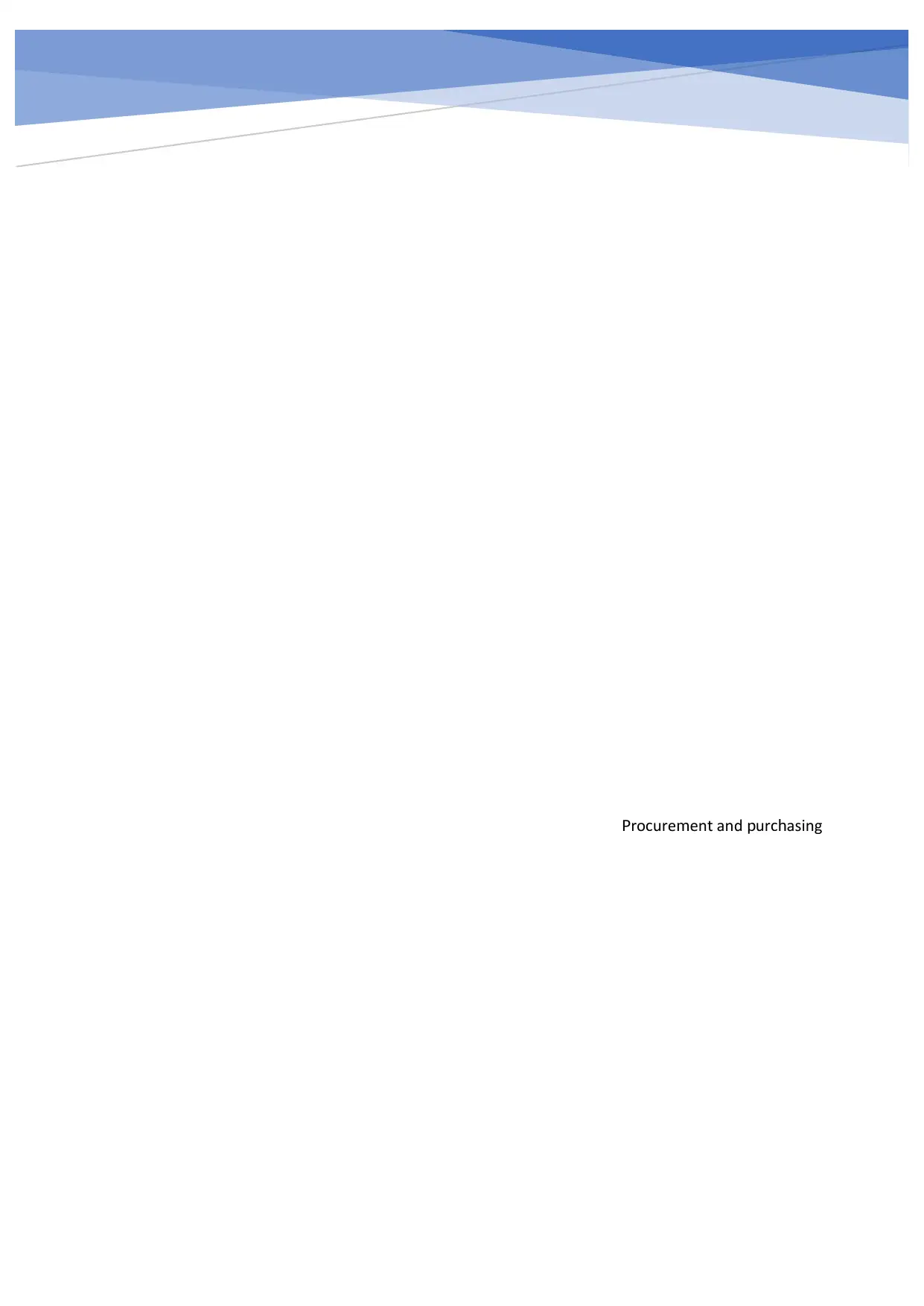
ro ure ent and ur asingP c m p ch
Secure Best Marks with AI Grader
Need help grading? Try our AI Grader for instant feedback on your assignments.
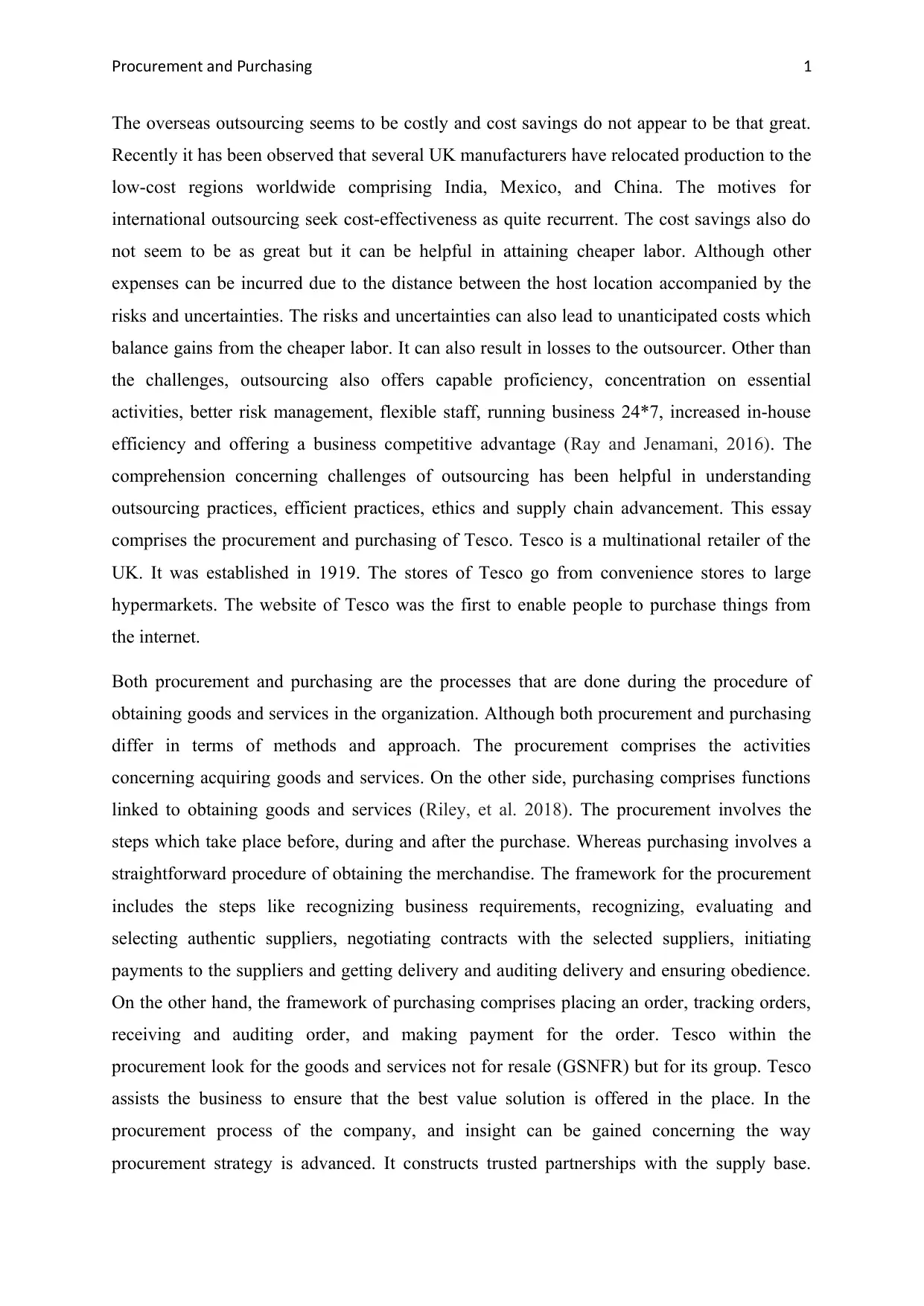
ro ure ent and ur asingP c m P ch 1
The overseas outsourcing seems to be costly and cost savings do not appear to be that great.
Recently it has been observed that several UK manufacturers have relocated production to the
low-cost regions worldwide comprising India, Mexico, and China. The motives for
international outsourcing seek cost-effectiveness as quite recurrent. The cost savings also do
not seem to be as great but it can be helpful in attaining cheaper labor. Although other
expenses can be incurred due to the distance between the host location accompanied by the
risks and uncertainties. The risks and uncertainties can also lead to unanticipated costs which
balance gains from the cheaper labor. It can also result in losses to the outsourcer. Other than
the challenges, outsourcing also offers capable proficiency, concentration on essential
activities, better risk management, flexible staff, running business 24*7, increased in-house
efficiency and offering a business competitive advantage (Ray and Jenamani, 2016). The
comprehension concerning challenges of outsourcing has been helpful in understanding
outsourcing practices, efficient practices, ethics and supply chain advancement. This essay
comprises the procurement and purchasing of Tesco. Tesco is a multinational retailer of the
UK. It was established in 1919. The stores of Tesco go from convenience stores to large
hypermarkets. The website of Tesco was the first to enable people to purchase things from
the internet.
Both procurement and purchasing are the processes that are done during the procedure of
obtaining goods and services in the organization. Although both procurement and purchasing
differ in terms of methods and approach. The procurement comprises the activities
concerning acquiring goods and services. On the other side, purchasing comprises functions
linked to obtaining goods and services (Riley, et al. 2018). The procurement involves the
steps which take place before, during and after the purchase. Whereas purchasing involves a
straightforward procedure of obtaining the merchandise. The framework for the procurement
includes the steps like recognizing business requirements, recognizing, evaluating and
selecting authentic suppliers, negotiating contracts with the selected suppliers, initiating
payments to the suppliers and getting delivery and auditing delivery and ensuring obedience.
On the other hand, the framework of purchasing comprises placing an order, tracking orders,
receiving and auditing order, and making payment for the order. Tesco within the
procurement look for the goods and services not for resale (GSNFR) but for its group. Tesco
assists the business to ensure that the best value solution is offered in the place. In the
procurement process of the company, and insight can be gained concerning the way
procurement strategy is advanced. It constructs trusted partnerships with the supply base.
The overseas outsourcing seems to be costly and cost savings do not appear to be that great.
Recently it has been observed that several UK manufacturers have relocated production to the
low-cost regions worldwide comprising India, Mexico, and China. The motives for
international outsourcing seek cost-effectiveness as quite recurrent. The cost savings also do
not seem to be as great but it can be helpful in attaining cheaper labor. Although other
expenses can be incurred due to the distance between the host location accompanied by the
risks and uncertainties. The risks and uncertainties can also lead to unanticipated costs which
balance gains from the cheaper labor. It can also result in losses to the outsourcer. Other than
the challenges, outsourcing also offers capable proficiency, concentration on essential
activities, better risk management, flexible staff, running business 24*7, increased in-house
efficiency and offering a business competitive advantage (Ray and Jenamani, 2016). The
comprehension concerning challenges of outsourcing has been helpful in understanding
outsourcing practices, efficient practices, ethics and supply chain advancement. This essay
comprises the procurement and purchasing of Tesco. Tesco is a multinational retailer of the
UK. It was established in 1919. The stores of Tesco go from convenience stores to large
hypermarkets. The website of Tesco was the first to enable people to purchase things from
the internet.
Both procurement and purchasing are the processes that are done during the procedure of
obtaining goods and services in the organization. Although both procurement and purchasing
differ in terms of methods and approach. The procurement comprises the activities
concerning acquiring goods and services. On the other side, purchasing comprises functions
linked to obtaining goods and services (Riley, et al. 2018). The procurement involves the
steps which take place before, during and after the purchase. Whereas purchasing involves a
straightforward procedure of obtaining the merchandise. The framework for the procurement
includes the steps like recognizing business requirements, recognizing, evaluating and
selecting authentic suppliers, negotiating contracts with the selected suppliers, initiating
payments to the suppliers and getting delivery and auditing delivery and ensuring obedience.
On the other hand, the framework of purchasing comprises placing an order, tracking orders,
receiving and auditing order, and making payment for the order. Tesco within the
procurement look for the goods and services not for resale (GSNFR) but for its group. Tesco
assists the business to ensure that the best value solution is offered in the place. In the
procurement process of the company, and insight can be gained concerning the way
procurement strategy is advanced. It constructs trusted partnerships with the supply base.
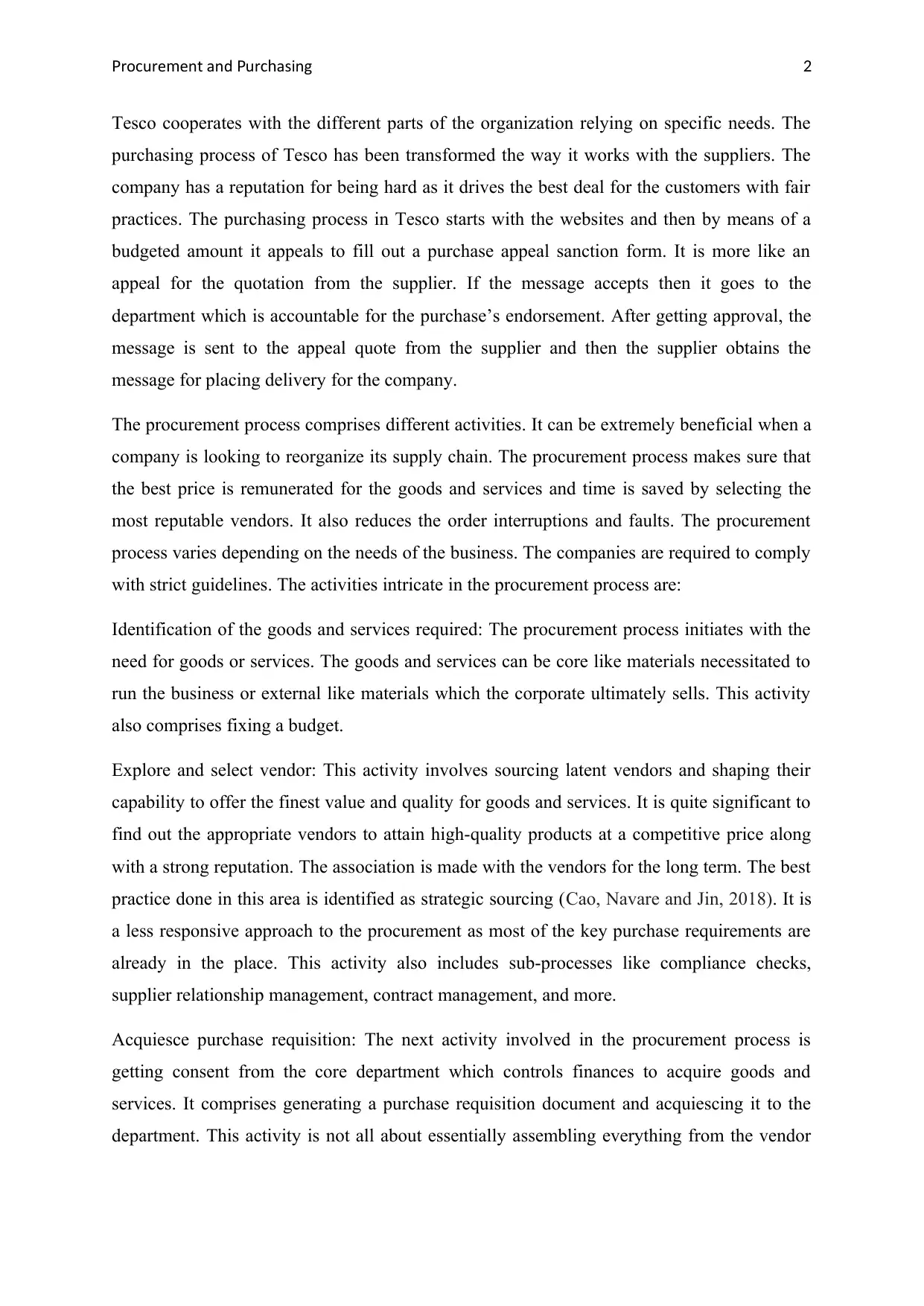
ro ure ent and ur asingP c m P ch 2
Tesco cooperates with the different parts of the organization relying on specific needs. The
purchasing process of Tesco has been transformed the way it works with the suppliers. The
company has a reputation for being hard as it drives the best deal for the customers with fair
practices. The purchasing process in Tesco starts with the websites and then by means of a
budgeted amount it appeals to fill out a purchase appeal sanction form. It is more like an
appeal for the quotation from the supplier. If the message accepts then it goes to the
department which is accountable for the purchase’s endorsement. After getting approval, the
message is sent to the appeal quote from the supplier and then the supplier obtains the
message for placing delivery for the company.
The procurement process comprises different activities. It can be extremely beneficial when a
company is looking to reorganize its supply chain. The procurement process makes sure that
the best price is remunerated for the goods and services and time is saved by selecting the
most reputable vendors. It also reduces the order interruptions and faults. The procurement
process varies depending on the needs of the business. The companies are required to comply
with strict guidelines. The activities intricate in the procurement process are:
Identification of the goods and services required: The procurement process initiates with the
need for goods or services. The goods and services can be core like materials necessitated to
run the business or external like materials which the corporate ultimately sells. This activity
also comprises fixing a budget.
Explore and select vendor: This activity involves sourcing latent vendors and shaping their
capability to offer the finest value and quality for goods and services. It is quite significant to
find out the appropriate vendors to attain high-quality products at a competitive price along
with a strong reputation. The association is made with the vendors for the long term. The best
practice done in this area is identified as strategic sourcing (Cao, Navare and Jin, 2018). It is
a less responsive approach to the procurement as most of the key purchase requirements are
already in the place. This activity also includes sub-processes like compliance checks,
supplier relationship management, contract management, and more.
Acquiesce purchase requisition: The next activity involved in the procurement process is
getting consent from the core department which controls finances to acquire goods and
services. It comprises generating a purchase requisition document and acquiescing it to the
department. This activity is not all about essentially assembling everything from the vendor
Tesco cooperates with the different parts of the organization relying on specific needs. The
purchasing process of Tesco has been transformed the way it works with the suppliers. The
company has a reputation for being hard as it drives the best deal for the customers with fair
practices. The purchasing process in Tesco starts with the websites and then by means of a
budgeted amount it appeals to fill out a purchase appeal sanction form. It is more like an
appeal for the quotation from the supplier. If the message accepts then it goes to the
department which is accountable for the purchase’s endorsement. After getting approval, the
message is sent to the appeal quote from the supplier and then the supplier obtains the
message for placing delivery for the company.
The procurement process comprises different activities. It can be extremely beneficial when a
company is looking to reorganize its supply chain. The procurement process makes sure that
the best price is remunerated for the goods and services and time is saved by selecting the
most reputable vendors. It also reduces the order interruptions and faults. The procurement
process varies depending on the needs of the business. The companies are required to comply
with strict guidelines. The activities intricate in the procurement process are:
Identification of the goods and services required: The procurement process initiates with the
need for goods or services. The goods and services can be core like materials necessitated to
run the business or external like materials which the corporate ultimately sells. This activity
also comprises fixing a budget.
Explore and select vendor: This activity involves sourcing latent vendors and shaping their
capability to offer the finest value and quality for goods and services. It is quite significant to
find out the appropriate vendors to attain high-quality products at a competitive price along
with a strong reputation. The association is made with the vendors for the long term. The best
practice done in this area is identified as strategic sourcing (Cao, Navare and Jin, 2018). It is
a less responsive approach to the procurement as most of the key purchase requirements are
already in the place. This activity also includes sub-processes like compliance checks,
supplier relationship management, contract management, and more.
Acquiesce purchase requisition: The next activity involved in the procurement process is
getting consent from the core department which controls finances to acquire goods and
services. It comprises generating a purchase requisition document and acquiescing it to the
department. This activity is not all about essentially assembling everything from the vendor
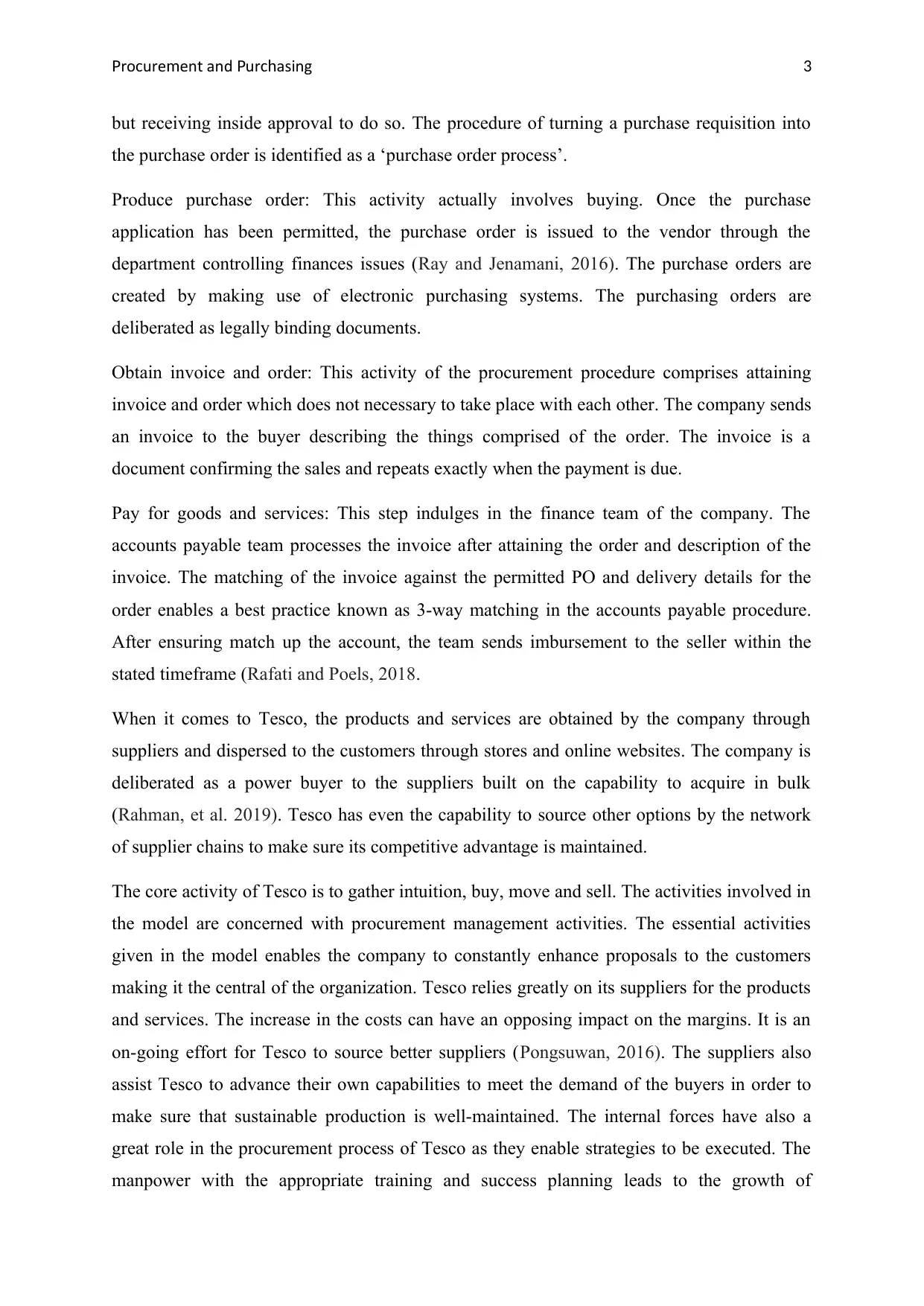
ro ure ent and ur asingP c m P ch 3
but receiving inside approval to do so. The procedure of turning a purchase requisition into
the purchase order is identified as a ‘purchase order process’.
Produce purchase order: This activity actually involves buying. Once the purchase
application has been permitted, the purchase order is issued to the vendor through the
department controlling finances issues (Ray and Jenamani, 2016). The purchase orders are
created by making use of electronic purchasing systems. The purchasing orders are
deliberated as legally binding documents.
Obtain invoice and order: This activity of the procurement procedure comprises attaining
invoice and order which does not necessary to take place with each other. The company sends
an invoice to the buyer describing the things comprised of the order. The invoice is a
document confirming the sales and repeats exactly when the payment is due.
Pay for goods and services: This step indulges in the finance team of the company. The
accounts payable team processes the invoice after attaining the order and description of the
invoice. The matching of the invoice against the permitted PO and delivery details for the
order enables a best practice known as 3-way matching in the accounts payable procedure.
After ensuring match up the account, the team sends imbursement to the seller within the
stated timeframe (Rafati and Poels, 2018.
When it comes to Tesco, the products and services are obtained by the company through
suppliers and dispersed to the customers through stores and online websites. The company is
deliberated as a power buyer to the suppliers built on the capability to acquire in bulk
(Rahman, et al. 2019). Tesco has even the capability to source other options by the network
of supplier chains to make sure its competitive advantage is maintained.
The core activity of Tesco is to gather intuition, buy, move and sell. The activities involved in
the model are concerned with procurement management activities. The essential activities
given in the model enables the company to constantly enhance proposals to the customers
making it the central of the organization. Tesco relies greatly on its suppliers for the products
and services. The increase in the costs can have an opposing impact on the margins. It is an
on-going effort for Tesco to source better suppliers (Pongsuwan, 2016). The suppliers also
assist Tesco to advance their own capabilities to meet the demand of the buyers in order to
make sure that sustainable production is well-maintained. The internal forces have also a
great role in the procurement process of Tesco as they enable strategies to be executed. The
manpower with the appropriate training and success planning leads to the growth of
but receiving inside approval to do so. The procedure of turning a purchase requisition into
the purchase order is identified as a ‘purchase order process’.
Produce purchase order: This activity actually involves buying. Once the purchase
application has been permitted, the purchase order is issued to the vendor through the
department controlling finances issues (Ray and Jenamani, 2016). The purchase orders are
created by making use of electronic purchasing systems. The purchasing orders are
deliberated as legally binding documents.
Obtain invoice and order: This activity of the procurement procedure comprises attaining
invoice and order which does not necessary to take place with each other. The company sends
an invoice to the buyer describing the things comprised of the order. The invoice is a
document confirming the sales and repeats exactly when the payment is due.
Pay for goods and services: This step indulges in the finance team of the company. The
accounts payable team processes the invoice after attaining the order and description of the
invoice. The matching of the invoice against the permitted PO and delivery details for the
order enables a best practice known as 3-way matching in the accounts payable procedure.
After ensuring match up the account, the team sends imbursement to the seller within the
stated timeframe (Rafati and Poels, 2018.
When it comes to Tesco, the products and services are obtained by the company through
suppliers and dispersed to the customers through stores and online websites. The company is
deliberated as a power buyer to the suppliers built on the capability to acquire in bulk
(Rahman, et al. 2019). Tesco has even the capability to source other options by the network
of supplier chains to make sure its competitive advantage is maintained.
The core activity of Tesco is to gather intuition, buy, move and sell. The activities involved in
the model are concerned with procurement management activities. The essential activities
given in the model enables the company to constantly enhance proposals to the customers
making it the central of the organization. Tesco relies greatly on its suppliers for the products
and services. The increase in the costs can have an opposing impact on the margins. It is an
on-going effort for Tesco to source better suppliers (Pongsuwan, 2016). The suppliers also
assist Tesco to advance their own capabilities to meet the demand of the buyers in order to
make sure that sustainable production is well-maintained. The internal forces have also a
great role in the procurement process of Tesco as they enable strategies to be executed. The
manpower with the appropriate training and success planning leads to the growth of
Secure Best Marks with AI Grader
Need help grading? Try our AI Grader for instant feedback on your assignments.
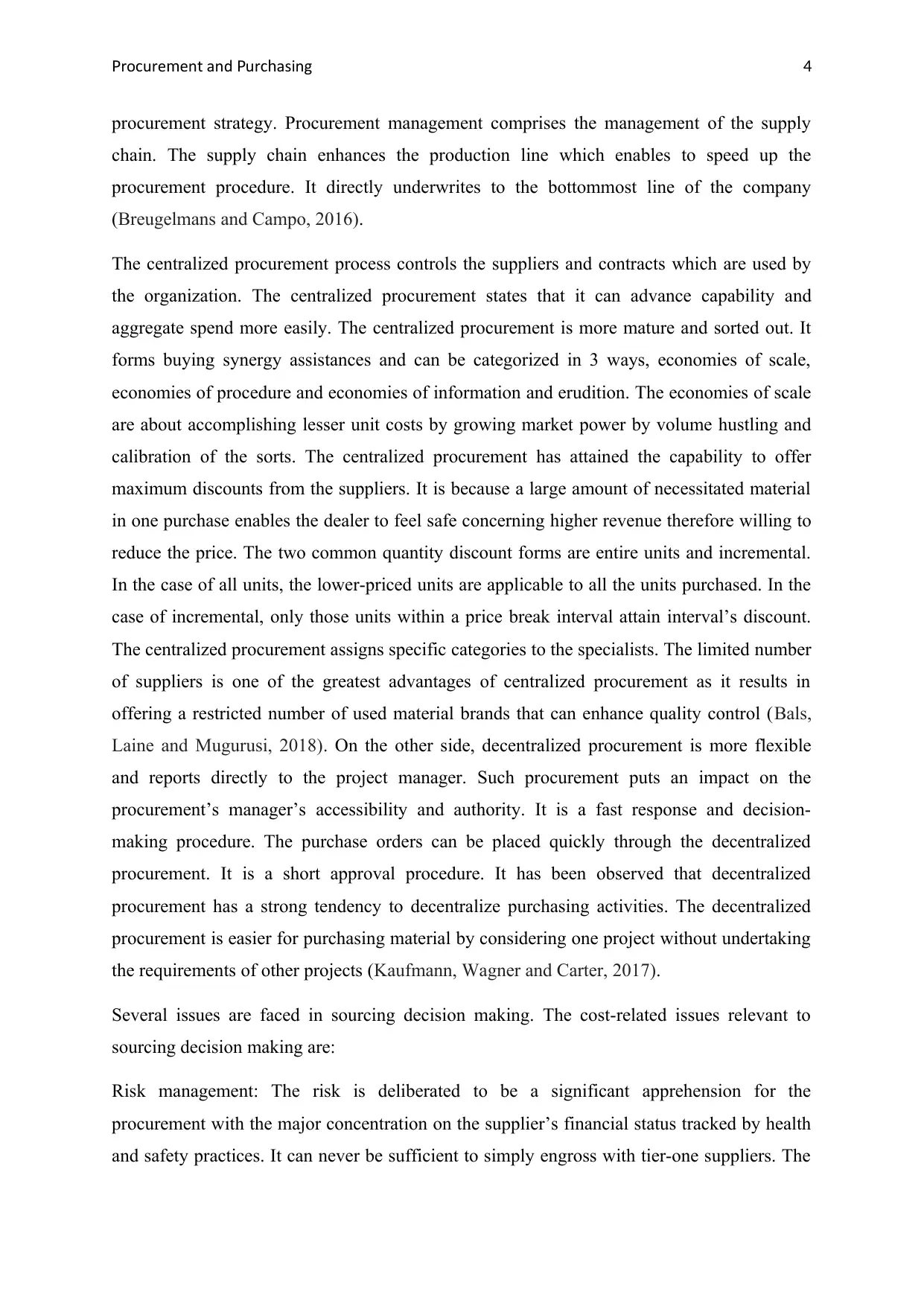
ro ure ent and ur asingP c m P ch 4
procurement strategy. Procurement management comprises the management of the supply
chain. The supply chain enhances the production line which enables to speed up the
procurement procedure. It directly underwrites to the bottommost line of the company
(Breugelmans and Campo, 2016).
The centralized procurement process controls the suppliers and contracts which are used by
the organization. The centralized procurement states that it can advance capability and
aggregate spend more easily. The centralized procurement is more mature and sorted out. It
forms buying synergy assistances and can be categorized in 3 ways, economies of scale,
economies of procedure and economies of information and erudition. The economies of scale
are about accomplishing lesser unit costs by growing market power by volume hustling and
calibration of the sorts. The centralized procurement has attained the capability to offer
maximum discounts from the suppliers. It is because a large amount of necessitated material
in one purchase enables the dealer to feel safe concerning higher revenue therefore willing to
reduce the price. The two common quantity discount forms are entire units and incremental.
In the case of all units, the lower-priced units are applicable to all the units purchased. In the
case of incremental, only those units within a price break interval attain interval’s discount.
The centralized procurement assigns specific categories to the specialists. The limited number
of suppliers is one of the greatest advantages of centralized procurement as it results in
offering a restricted number of used material brands that can enhance quality control (Bals,
Laine and Mugurusi, 2018). On the other side, decentralized procurement is more flexible
and reports directly to the project manager. Such procurement puts an impact on the
procurement’s manager’s accessibility and authority. It is a fast response and decision-
making procedure. The purchase orders can be placed quickly through the decentralized
procurement. It is a short approval procedure. It has been observed that decentralized
procurement has a strong tendency to decentralize purchasing activities. The decentralized
procurement is easier for purchasing material by considering one project without undertaking
the requirements of other projects (Kaufmann, Wagner and Carter, 2017).
Several issues are faced in sourcing decision making. The cost-related issues relevant to
sourcing decision making are:
Risk management: The risk is deliberated to be a significant apprehension for the
procurement with the major concentration on the supplier’s financial status tracked by health
and safety practices. It can never be sufficient to simply engross with tier-one suppliers. The
procurement strategy. Procurement management comprises the management of the supply
chain. The supply chain enhances the production line which enables to speed up the
procurement procedure. It directly underwrites to the bottommost line of the company
(Breugelmans and Campo, 2016).
The centralized procurement process controls the suppliers and contracts which are used by
the organization. The centralized procurement states that it can advance capability and
aggregate spend more easily. The centralized procurement is more mature and sorted out. It
forms buying synergy assistances and can be categorized in 3 ways, economies of scale,
economies of procedure and economies of information and erudition. The economies of scale
are about accomplishing lesser unit costs by growing market power by volume hustling and
calibration of the sorts. The centralized procurement has attained the capability to offer
maximum discounts from the suppliers. It is because a large amount of necessitated material
in one purchase enables the dealer to feel safe concerning higher revenue therefore willing to
reduce the price. The two common quantity discount forms are entire units and incremental.
In the case of all units, the lower-priced units are applicable to all the units purchased. In the
case of incremental, only those units within a price break interval attain interval’s discount.
The centralized procurement assigns specific categories to the specialists. The limited number
of suppliers is one of the greatest advantages of centralized procurement as it results in
offering a restricted number of used material brands that can enhance quality control (Bals,
Laine and Mugurusi, 2018). On the other side, decentralized procurement is more flexible
and reports directly to the project manager. Such procurement puts an impact on the
procurement’s manager’s accessibility and authority. It is a fast response and decision-
making procedure. The purchase orders can be placed quickly through the decentralized
procurement. It is a short approval procedure. It has been observed that decentralized
procurement has a strong tendency to decentralize purchasing activities. The decentralized
procurement is easier for purchasing material by considering one project without undertaking
the requirements of other projects (Kaufmann, Wagner and Carter, 2017).
Several issues are faced in sourcing decision making. The cost-related issues relevant to
sourcing decision making are:
Risk management: The risk is deliberated to be a significant apprehension for the
procurement with the major concentration on the supplier’s financial status tracked by health
and safety practices. It can never be sufficient to simply engross with tier-one suppliers. The
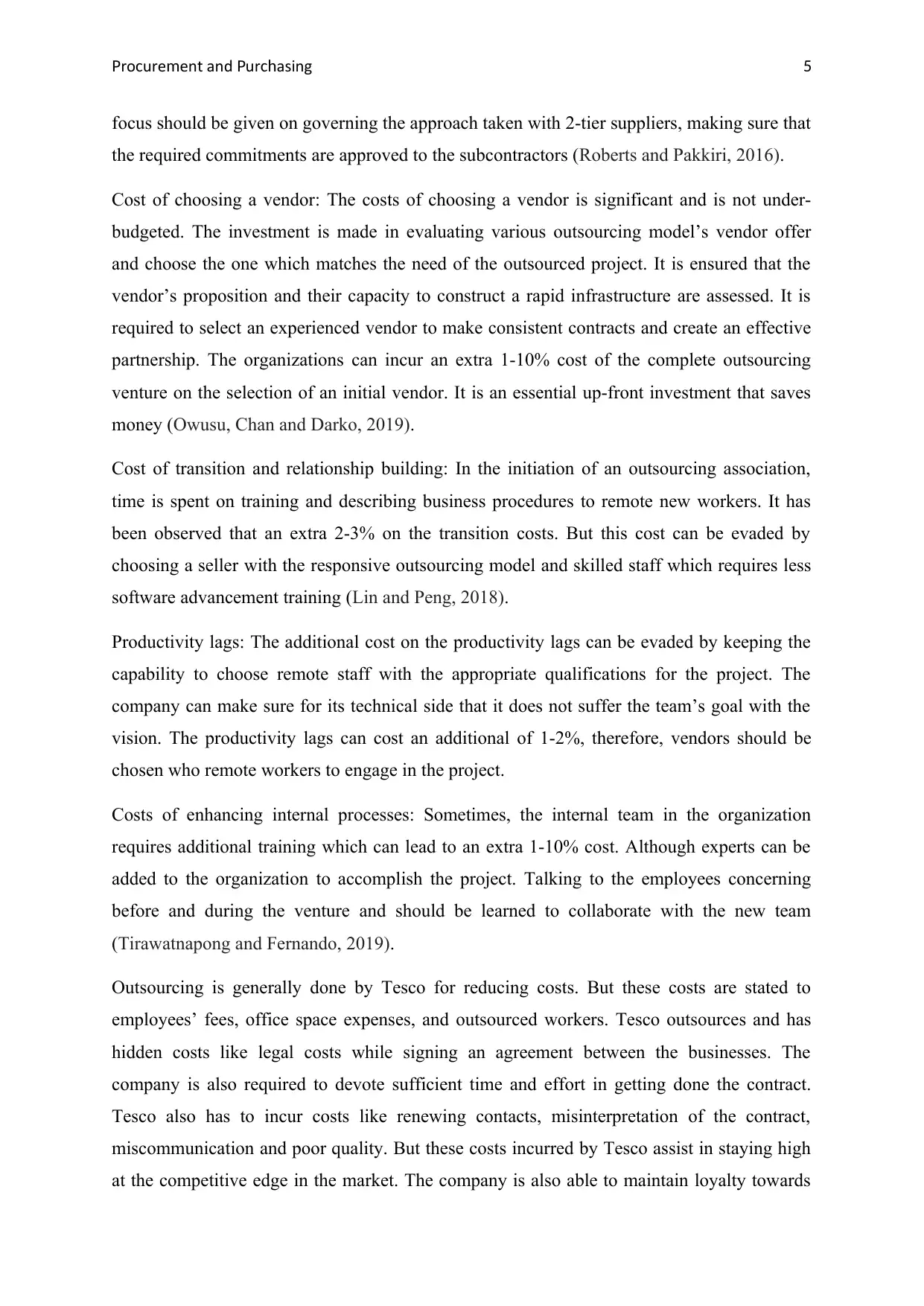
ro ure ent and ur asingP c m P ch 5
focus should be given on governing the approach taken with 2-tier suppliers, making sure that
the required commitments are approved to the subcontractors (Roberts and Pakkiri, 2016).
Cost of choosing a vendor: The costs of choosing a vendor is significant and is not under-
budgeted. The investment is made in evaluating various outsourcing model’s vendor offer
and choose the one which matches the need of the outsourced project. It is ensured that the
vendor’s proposition and their capacity to construct a rapid infrastructure are assessed. It is
required to select an experienced vendor to make consistent contracts and create an effective
partnership. The organizations can incur an extra 1-10% cost of the complete outsourcing
venture on the selection of an initial vendor. It is an essential up-front investment that saves
money (Owusu, Chan and Darko, 2019).
Cost of transition and relationship building: In the initiation of an outsourcing association,
time is spent on training and describing business procedures to remote new workers. It has
been observed that an extra 2-3% on the transition costs. But this cost can be evaded by
choosing a seller with the responsive outsourcing model and skilled staff which requires less
software advancement training (Lin and Peng, 2018).
Productivity lags: The additional cost on the productivity lags can be evaded by keeping the
capability to choose remote staff with the appropriate qualifications for the project. The
company can make sure for its technical side that it does not suffer the team’s goal with the
vision. The productivity lags can cost an additional of 1-2%, therefore, vendors should be
chosen who remote workers to engage in the project.
Costs of enhancing internal processes: Sometimes, the internal team in the organization
requires additional training which can lead to an extra 1-10% cost. Although experts can be
added to the organization to accomplish the project. Talking to the employees concerning
before and during the venture and should be learned to collaborate with the new team
(Tirawatnapong and Fernando, 2019).
Outsourcing is generally done by Tesco for reducing costs. But these costs are stated to
employees’ fees, office space expenses, and outsourced workers. Tesco outsources and has
hidden costs like legal costs while signing an agreement between the businesses. The
company is also required to devote sufficient time and effort in getting done the contract.
Tesco also has to incur costs like renewing contacts, misinterpretation of the contract,
miscommunication and poor quality. But these costs incurred by Tesco assist in staying high
at the competitive edge in the market. The company is also able to maintain loyalty towards
focus should be given on governing the approach taken with 2-tier suppliers, making sure that
the required commitments are approved to the subcontractors (Roberts and Pakkiri, 2016).
Cost of choosing a vendor: The costs of choosing a vendor is significant and is not under-
budgeted. The investment is made in evaluating various outsourcing model’s vendor offer
and choose the one which matches the need of the outsourced project. It is ensured that the
vendor’s proposition and their capacity to construct a rapid infrastructure are assessed. It is
required to select an experienced vendor to make consistent contracts and create an effective
partnership. The organizations can incur an extra 1-10% cost of the complete outsourcing
venture on the selection of an initial vendor. It is an essential up-front investment that saves
money (Owusu, Chan and Darko, 2019).
Cost of transition and relationship building: In the initiation of an outsourcing association,
time is spent on training and describing business procedures to remote new workers. It has
been observed that an extra 2-3% on the transition costs. But this cost can be evaded by
choosing a seller with the responsive outsourcing model and skilled staff which requires less
software advancement training (Lin and Peng, 2018).
Productivity lags: The additional cost on the productivity lags can be evaded by keeping the
capability to choose remote staff with the appropriate qualifications for the project. The
company can make sure for its technical side that it does not suffer the team’s goal with the
vision. The productivity lags can cost an additional of 1-2%, therefore, vendors should be
chosen who remote workers to engage in the project.
Costs of enhancing internal processes: Sometimes, the internal team in the organization
requires additional training which can lead to an extra 1-10% cost. Although experts can be
added to the organization to accomplish the project. Talking to the employees concerning
before and during the venture and should be learned to collaborate with the new team
(Tirawatnapong and Fernando, 2019).
Outsourcing is generally done by Tesco for reducing costs. But these costs are stated to
employees’ fees, office space expenses, and outsourced workers. Tesco outsources and has
hidden costs like legal costs while signing an agreement between the businesses. The
company is also required to devote sufficient time and effort in getting done the contract.
Tesco also has to incur costs like renewing contacts, misinterpretation of the contract,
miscommunication and poor quality. But these costs incurred by Tesco assist in staying high
at the competitive edge in the market. The company is also able to maintain loyalty towards
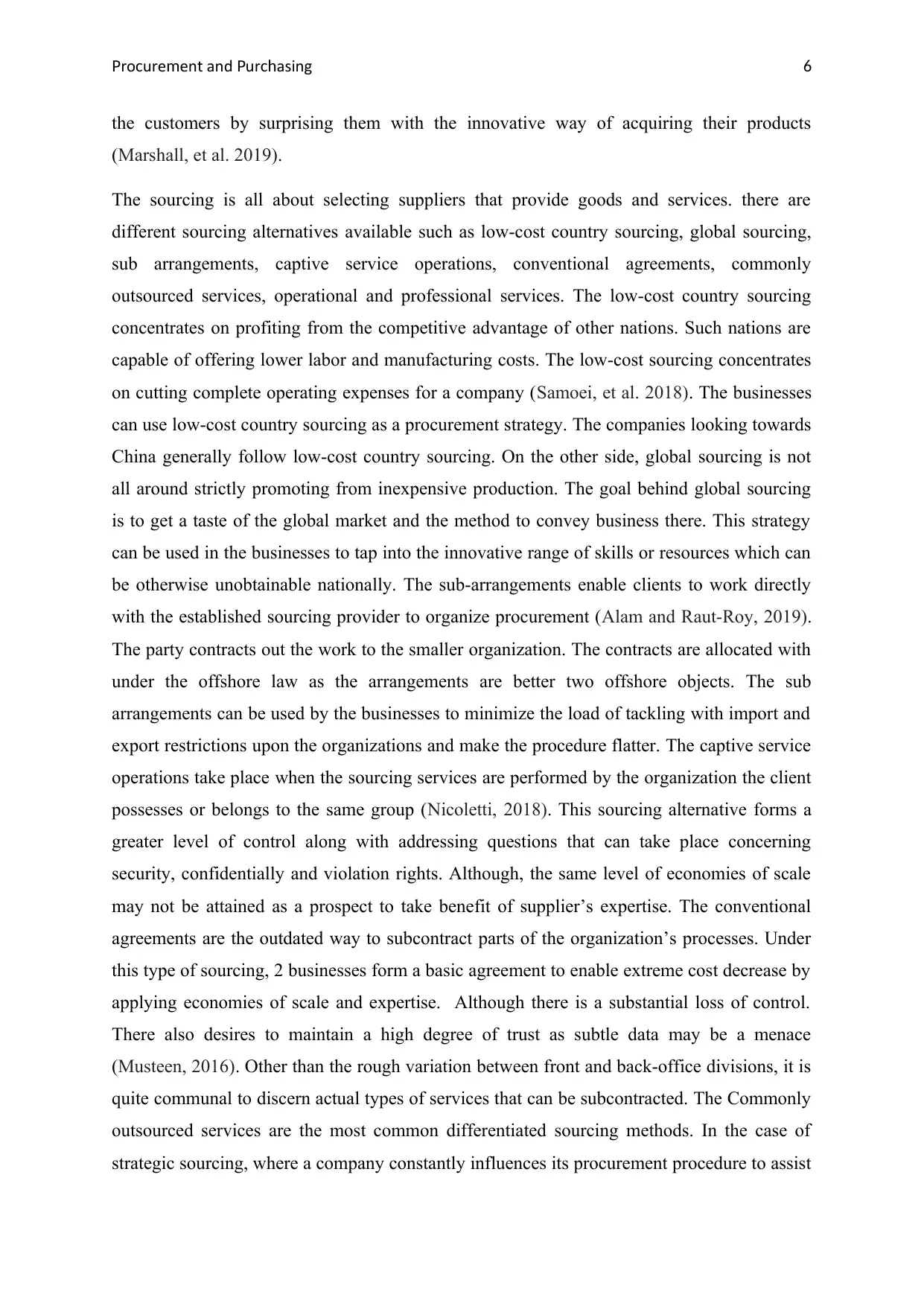
ro ure ent and ur asingP c m P ch 6
the customers by surprising them with the innovative way of acquiring their products
(Marshall, et al. 2019).
The sourcing is all about selecting suppliers that provide goods and services. there are
different sourcing alternatives available such as low-cost country sourcing, global sourcing,
sub arrangements, captive service operations, conventional agreements, commonly
outsourced services, operational and professional services. The low-cost country sourcing
concentrates on profiting from the competitive advantage of other nations. Such nations are
capable of offering lower labor and manufacturing costs. The low-cost sourcing concentrates
on cutting complete operating expenses for a company (Samoei, et al. 2018). The businesses
can use low-cost country sourcing as a procurement strategy. The companies looking towards
China generally follow low-cost country sourcing. On the other side, global sourcing is not
all around strictly promoting from inexpensive production. The goal behind global sourcing
is to get a taste of the global market and the method to convey business there. This strategy
can be used in the businesses to tap into the innovative range of skills or resources which can
be otherwise unobtainable nationally. The sub-arrangements enable clients to work directly
with the established sourcing provider to organize procurement (Alam and Raut-Roy, 2019).
The party contracts out the work to the smaller organization. The contracts are allocated with
under the offshore law as the arrangements are better two offshore objects. The sub
arrangements can be used by the businesses to minimize the load of tackling with import and
export restrictions upon the organizations and make the procedure flatter. The captive service
operations take place when the sourcing services are performed by the organization the client
possesses or belongs to the same group (Nicoletti, 2018). This sourcing alternative forms a
greater level of control along with addressing questions that can take place concerning
security, confidentially and violation rights. Although, the same level of economies of scale
may not be attained as a prospect to take benefit of supplier’s expertise. The conventional
agreements are the outdated way to subcontract parts of the organization’s processes. Under
this type of sourcing, 2 businesses form a basic agreement to enable extreme cost decrease by
applying economies of scale and expertise. Although there is a substantial loss of control.
There also desires to maintain a high degree of trust as subtle data may be a menace
(Musteen, 2016). Other than the rough variation between front and back-office divisions, it is
quite communal to discern actual types of services that can be subcontracted. The Commonly
outsourced services are the most common differentiated sourcing methods. In the case of
strategic sourcing, where a company constantly influences its procurement procedure to assist
the customers by surprising them with the innovative way of acquiring their products
(Marshall, et al. 2019).
The sourcing is all about selecting suppliers that provide goods and services. there are
different sourcing alternatives available such as low-cost country sourcing, global sourcing,
sub arrangements, captive service operations, conventional agreements, commonly
outsourced services, operational and professional services. The low-cost country sourcing
concentrates on profiting from the competitive advantage of other nations. Such nations are
capable of offering lower labor and manufacturing costs. The low-cost sourcing concentrates
on cutting complete operating expenses for a company (Samoei, et al. 2018). The businesses
can use low-cost country sourcing as a procurement strategy. The companies looking towards
China generally follow low-cost country sourcing. On the other side, global sourcing is not
all around strictly promoting from inexpensive production. The goal behind global sourcing
is to get a taste of the global market and the method to convey business there. This strategy
can be used in the businesses to tap into the innovative range of skills or resources which can
be otherwise unobtainable nationally. The sub-arrangements enable clients to work directly
with the established sourcing provider to organize procurement (Alam and Raut-Roy, 2019).
The party contracts out the work to the smaller organization. The contracts are allocated with
under the offshore law as the arrangements are better two offshore objects. The sub
arrangements can be used by the businesses to minimize the load of tackling with import and
export restrictions upon the organizations and make the procedure flatter. The captive service
operations take place when the sourcing services are performed by the organization the client
possesses or belongs to the same group (Nicoletti, 2018). This sourcing alternative forms a
greater level of control along with addressing questions that can take place concerning
security, confidentially and violation rights. Although, the same level of economies of scale
may not be attained as a prospect to take benefit of supplier’s expertise. The conventional
agreements are the outdated way to subcontract parts of the organization’s processes. Under
this type of sourcing, 2 businesses form a basic agreement to enable extreme cost decrease by
applying economies of scale and expertise. Although there is a substantial loss of control.
There also desires to maintain a high degree of trust as subtle data may be a menace
(Musteen, 2016). Other than the rough variation between front and back-office divisions, it is
quite communal to discern actual types of services that can be subcontracted. The Commonly
outsourced services are the most common differentiated sourcing methods. In the case of
strategic sourcing, where a company constantly influences its procurement procedure to assist
Paraphrase This Document
Need a fresh take? Get an instant paraphrase of this document with our AI Paraphraser
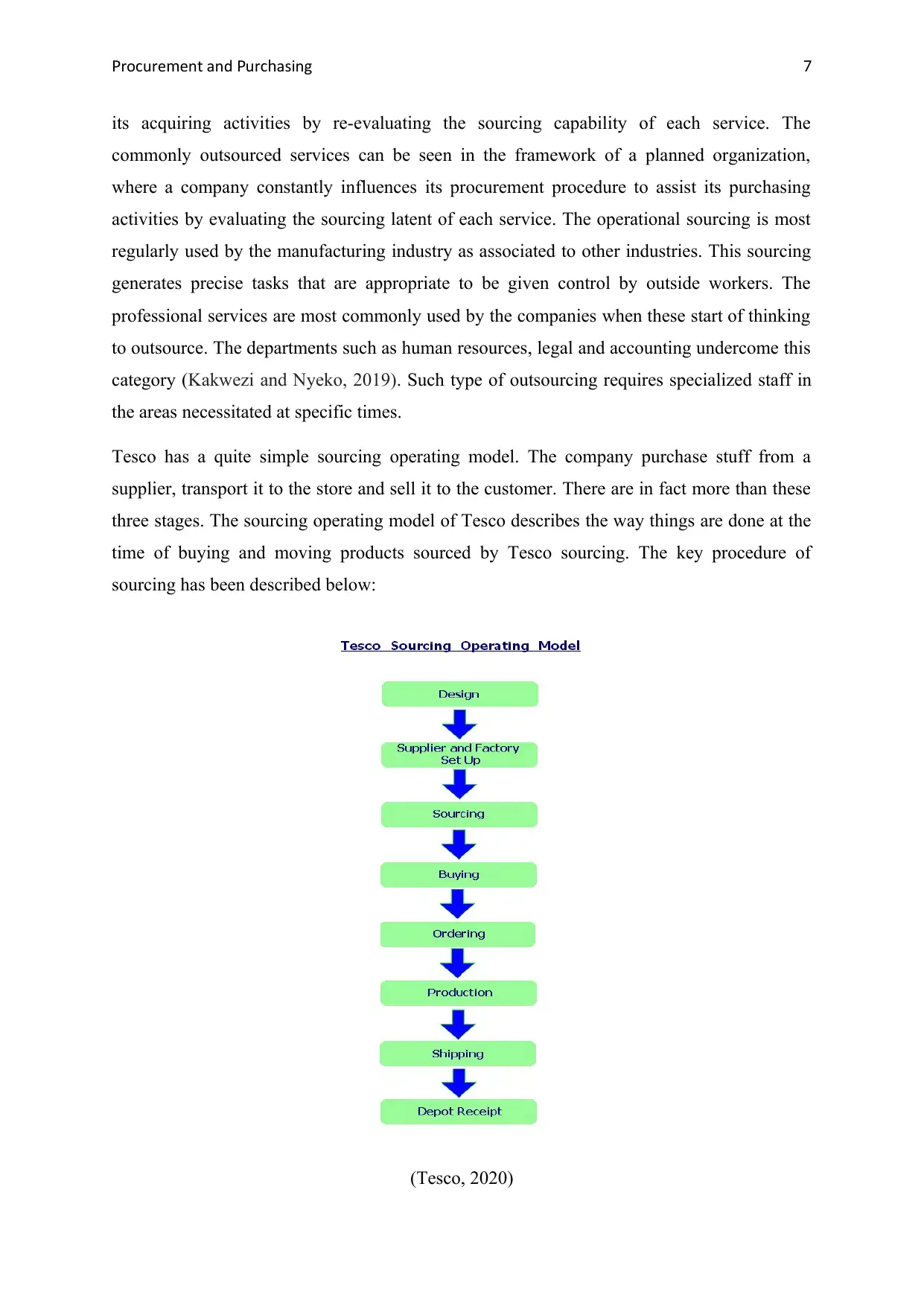
ro ure ent and ur asingP c m P ch 7
its acquiring activities by re-evaluating the sourcing capability of each service. The
commonly outsourced services can be seen in the framework of a planned organization,
where a company constantly influences its procurement procedure to assist its purchasing
activities by evaluating the sourcing latent of each service. The operational sourcing is most
regularly used by the manufacturing industry as associated to other industries. This sourcing
generates precise tasks that are appropriate to be given control by outside workers. The
professional services are most commonly used by the companies when these start of thinking
to outsource. The departments such as human resources, legal and accounting undercome this
category (Kakwezi and Nyeko, 2019). Such type of outsourcing requires specialized staff in
the areas necessitated at specific times.
Tesco has a quite simple sourcing operating model. The company purchase stuff from a
supplier, transport it to the store and sell it to the customer. There are in fact more than these
three stages. The sourcing operating model of Tesco describes the way things are done at the
time of buying and moving products sourced by Tesco sourcing. The key procedure of
sourcing has been described below:
(Tesco, 2020)
its acquiring activities by re-evaluating the sourcing capability of each service. The
commonly outsourced services can be seen in the framework of a planned organization,
where a company constantly influences its procurement procedure to assist its purchasing
activities by evaluating the sourcing latent of each service. The operational sourcing is most
regularly used by the manufacturing industry as associated to other industries. This sourcing
generates precise tasks that are appropriate to be given control by outside workers. The
professional services are most commonly used by the companies when these start of thinking
to outsource. The departments such as human resources, legal and accounting undercome this
category (Kakwezi and Nyeko, 2019). Such type of outsourcing requires specialized staff in
the areas necessitated at specific times.
Tesco has a quite simple sourcing operating model. The company purchase stuff from a
supplier, transport it to the store and sell it to the customer. There are in fact more than these
three stages. The sourcing operating model of Tesco describes the way things are done at the
time of buying and moving products sourced by Tesco sourcing. The key procedure of
sourcing has been described below:
(Tesco, 2020)
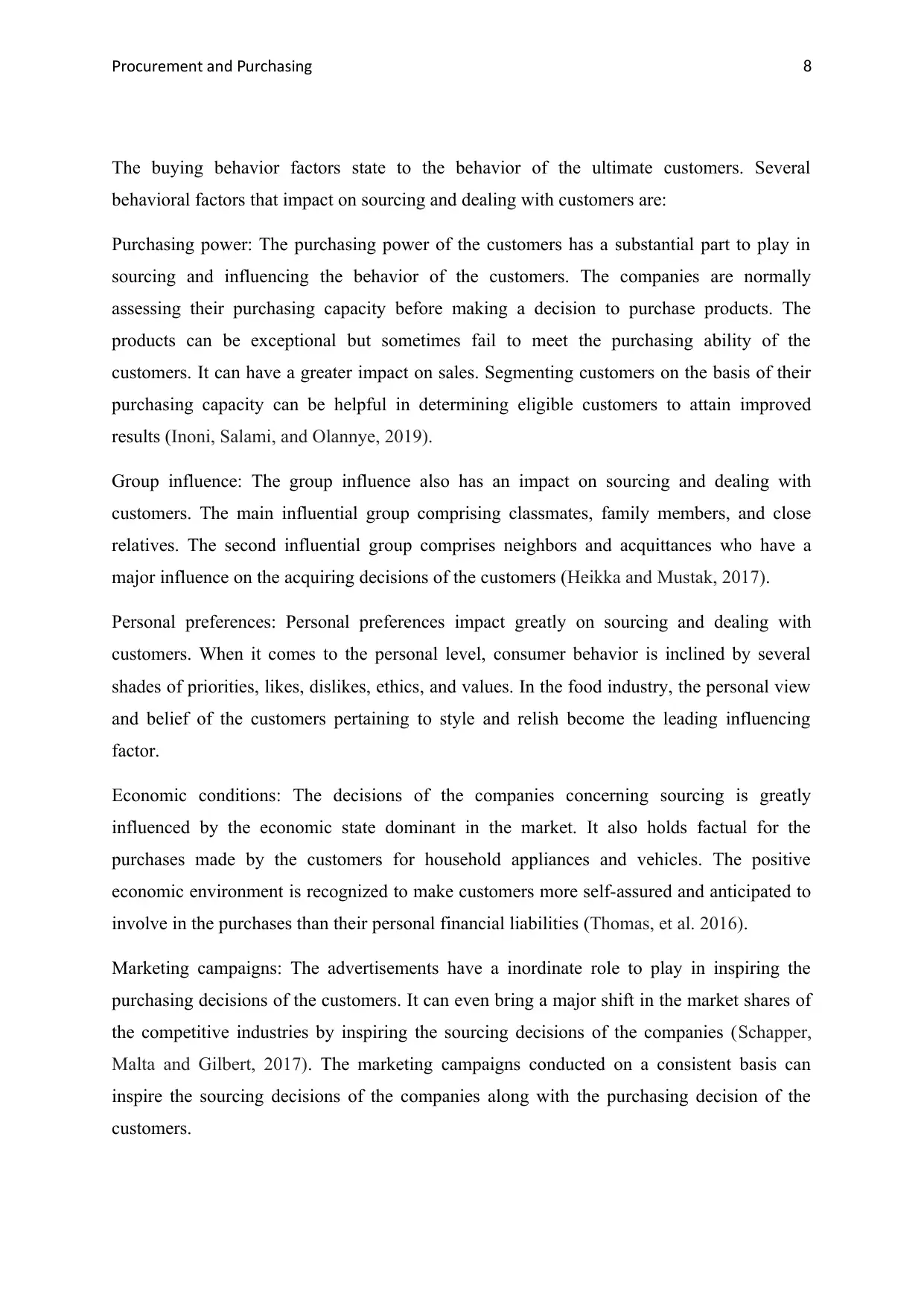
ro ure ent and ur asingP c m P ch 8
The buying behavior factors state to the behavior of the ultimate customers. Several
behavioral factors that impact on sourcing and dealing with customers are:
Purchasing power: The purchasing power of the customers has a substantial part to play in
sourcing and influencing the behavior of the customers. The companies are normally
assessing their purchasing capacity before making a decision to purchase products. The
products can be exceptional but sometimes fail to meet the purchasing ability of the
customers. It can have a greater impact on sales. Segmenting customers on the basis of their
purchasing capacity can be helpful in determining eligible customers to attain improved
results (Inoni, Salami, and Olannye, 2019).
Group influence: The group influence also has an impact on sourcing and dealing with
customers. The main influential group comprising classmates, family members, and close
relatives. The second influential group comprises neighbors and acquittances who have a
major influence on the acquiring decisions of the customers (Heikka and Mustak, 2017).
Personal preferences: Personal preferences impact greatly on sourcing and dealing with
customers. When it comes to the personal level, consumer behavior is inclined by several
shades of priorities, likes, dislikes, ethics, and values. In the food industry, the personal view
and belief of the customers pertaining to style and relish become the leading influencing
factor.
Economic conditions: The decisions of the companies concerning sourcing is greatly
influenced by the economic state dominant in the market. It also holds factual for the
purchases made by the customers for household appliances and vehicles. The positive
economic environment is recognized to make customers more self-assured and anticipated to
involve in the purchases than their personal financial liabilities (Thomas, et al. 2016).
Marketing campaigns: The advertisements have a inordinate role to play in inspiring the
purchasing decisions of the customers. It can even bring a major shift in the market shares of
the competitive industries by inspiring the sourcing decisions of the companies (Schapper,
Malta and Gilbert, 2017). The marketing campaigns conducted on a consistent basis can
inspire the sourcing decisions of the companies along with the purchasing decision of the
customers.
The buying behavior factors state to the behavior of the ultimate customers. Several
behavioral factors that impact on sourcing and dealing with customers are:
Purchasing power: The purchasing power of the customers has a substantial part to play in
sourcing and influencing the behavior of the customers. The companies are normally
assessing their purchasing capacity before making a decision to purchase products. The
products can be exceptional but sometimes fail to meet the purchasing ability of the
customers. It can have a greater impact on sales. Segmenting customers on the basis of their
purchasing capacity can be helpful in determining eligible customers to attain improved
results (Inoni, Salami, and Olannye, 2019).
Group influence: The group influence also has an impact on sourcing and dealing with
customers. The main influential group comprising classmates, family members, and close
relatives. The second influential group comprises neighbors and acquittances who have a
major influence on the acquiring decisions of the customers (Heikka and Mustak, 2017).
Personal preferences: Personal preferences impact greatly on sourcing and dealing with
customers. When it comes to the personal level, consumer behavior is inclined by several
shades of priorities, likes, dislikes, ethics, and values. In the food industry, the personal view
and belief of the customers pertaining to style and relish become the leading influencing
factor.
Economic conditions: The decisions of the companies concerning sourcing is greatly
influenced by the economic state dominant in the market. It also holds factual for the
purchases made by the customers for household appliances and vehicles. The positive
economic environment is recognized to make customers more self-assured and anticipated to
involve in the purchases than their personal financial liabilities (Thomas, et al. 2016).
Marketing campaigns: The advertisements have a inordinate role to play in inspiring the
purchasing decisions of the customers. It can even bring a major shift in the market shares of
the competitive industries by inspiring the sourcing decisions of the companies (Schapper,
Malta and Gilbert, 2017). The marketing campaigns conducted on a consistent basis can
inspire the sourcing decisions of the companies along with the purchasing decision of the
customers.
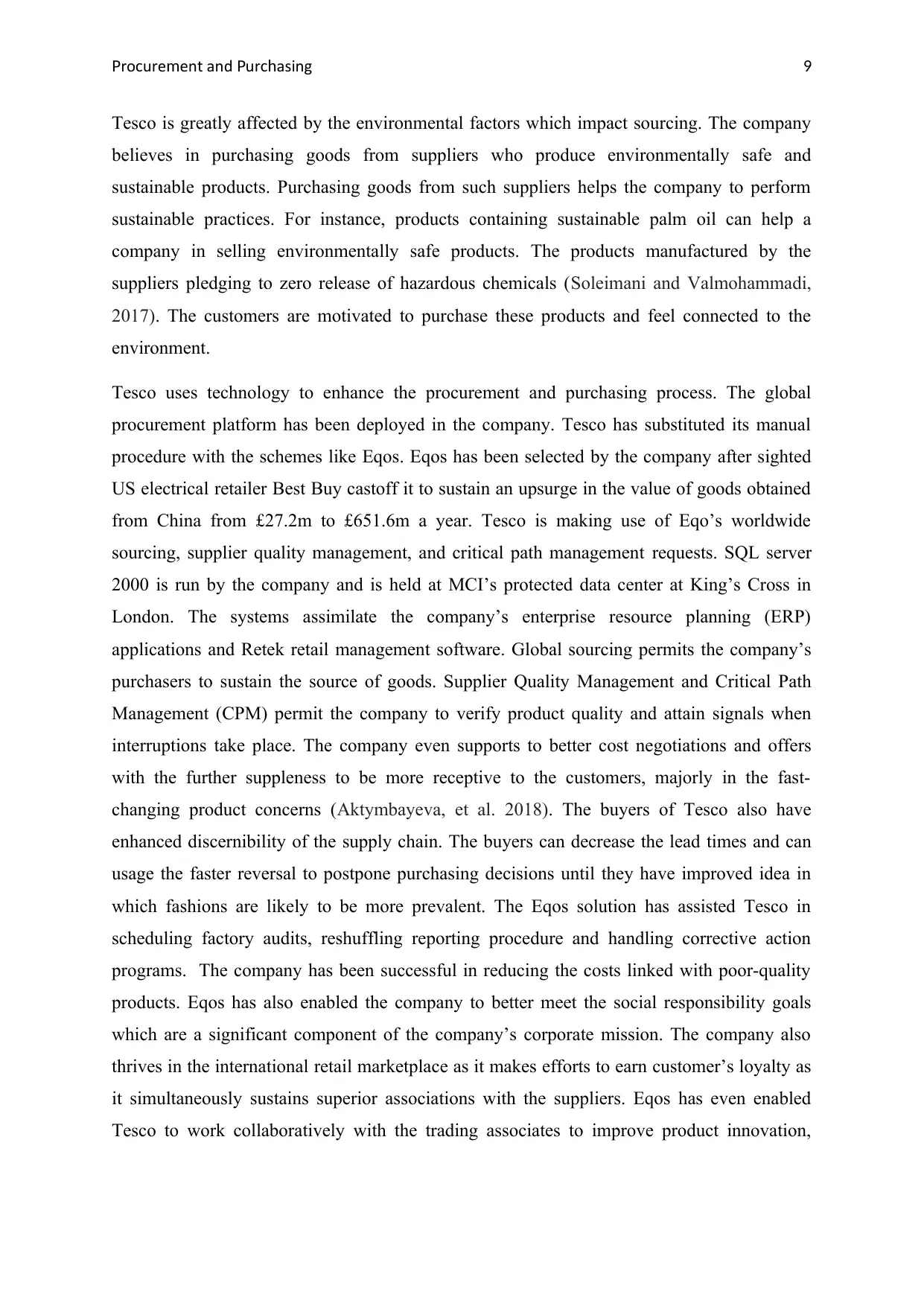
ro ure ent and ur asingP c m P ch 9
Tesco is greatly affected by the environmental factors which impact sourcing. The company
believes in purchasing goods from suppliers who produce environmentally safe and
sustainable products. Purchasing goods from such suppliers helps the company to perform
sustainable practices. For instance, products containing sustainable palm oil can help a
company in selling environmentally safe products. The products manufactured by the
suppliers pledging to zero release of hazardous chemicals (Soleimani and Valmohammadi,
2017). The customers are motivated to purchase these products and feel connected to the
environment.
Tesco uses technology to enhance the procurement and purchasing process. The global
procurement platform has been deployed in the company. Tesco has substituted its manual
procedure with the schemes like Eqos. Eqos has been selected by the company after sighted
US electrical retailer Best Buy castoff it to sustain an upsurge in the value of goods obtained
from China from £27.2m to £651.6m a year. Tesco is making use of Eqo’s worldwide
sourcing, supplier quality management, and critical path management requests. SQL server
2000 is run by the company and is held at MCI’s protected data center at King’s Cross in
London. The systems assimilate the company’s enterprise resource planning (ERP)
applications and Retek retail management software. Global sourcing permits the company’s
purchasers to sustain the source of goods. Supplier Quality Management and Critical Path
Management (CPM) permit the company to verify product quality and attain signals when
interruptions take place. The company even supports to better cost negotiations and offers
with the further suppleness to be more receptive to the customers, majorly in the fast-
changing product concerns (Aktymbayeva, et al. 2018). The buyers of Tesco also have
enhanced discernibility of the supply chain. The buyers can decrease the lead times and can
usage the faster reversal to postpone purchasing decisions until they have improved idea in
which fashions are likely to be more prevalent. The Eqos solution has assisted Tesco in
scheduling factory audits, reshuffling reporting procedure and handling corrective action
programs. The company has been successful in reducing the costs linked with poor-quality
products. Eqos has also enabled the company to better meet the social responsibility goals
which are a significant component of the company’s corporate mission. The company also
thrives in the international retail marketplace as it makes efforts to earn customer’s loyalty as
it simultaneously sustains superior associations with the suppliers. Eqos has even enabled
Tesco to work collaboratively with the trading associates to improve product innovation,
Tesco is greatly affected by the environmental factors which impact sourcing. The company
believes in purchasing goods from suppliers who produce environmentally safe and
sustainable products. Purchasing goods from such suppliers helps the company to perform
sustainable practices. For instance, products containing sustainable palm oil can help a
company in selling environmentally safe products. The products manufactured by the
suppliers pledging to zero release of hazardous chemicals (Soleimani and Valmohammadi,
2017). The customers are motivated to purchase these products and feel connected to the
environment.
Tesco uses technology to enhance the procurement and purchasing process. The global
procurement platform has been deployed in the company. Tesco has substituted its manual
procedure with the schemes like Eqos. Eqos has been selected by the company after sighted
US electrical retailer Best Buy castoff it to sustain an upsurge in the value of goods obtained
from China from £27.2m to £651.6m a year. Tesco is making use of Eqo’s worldwide
sourcing, supplier quality management, and critical path management requests. SQL server
2000 is run by the company and is held at MCI’s protected data center at King’s Cross in
London. The systems assimilate the company’s enterprise resource planning (ERP)
applications and Retek retail management software. Global sourcing permits the company’s
purchasers to sustain the source of goods. Supplier Quality Management and Critical Path
Management (CPM) permit the company to verify product quality and attain signals when
interruptions take place. The company even supports to better cost negotiations and offers
with the further suppleness to be more receptive to the customers, majorly in the fast-
changing product concerns (Aktymbayeva, et al. 2018). The buyers of Tesco also have
enhanced discernibility of the supply chain. The buyers can decrease the lead times and can
usage the faster reversal to postpone purchasing decisions until they have improved idea in
which fashions are likely to be more prevalent. The Eqos solution has assisted Tesco in
scheduling factory audits, reshuffling reporting procedure and handling corrective action
programs. The company has been successful in reducing the costs linked with poor-quality
products. Eqos has also enabled the company to better meet the social responsibility goals
which are a significant component of the company’s corporate mission. The company also
thrives in the international retail marketplace as it makes efforts to earn customer’s loyalty as
it simultaneously sustains superior associations with the suppliers. Eqos has even enabled
Tesco to work collaboratively with the trading associates to improve product innovation,
Secure Best Marks with AI Grader
Need help grading? Try our AI Grader for instant feedback on your assignments.
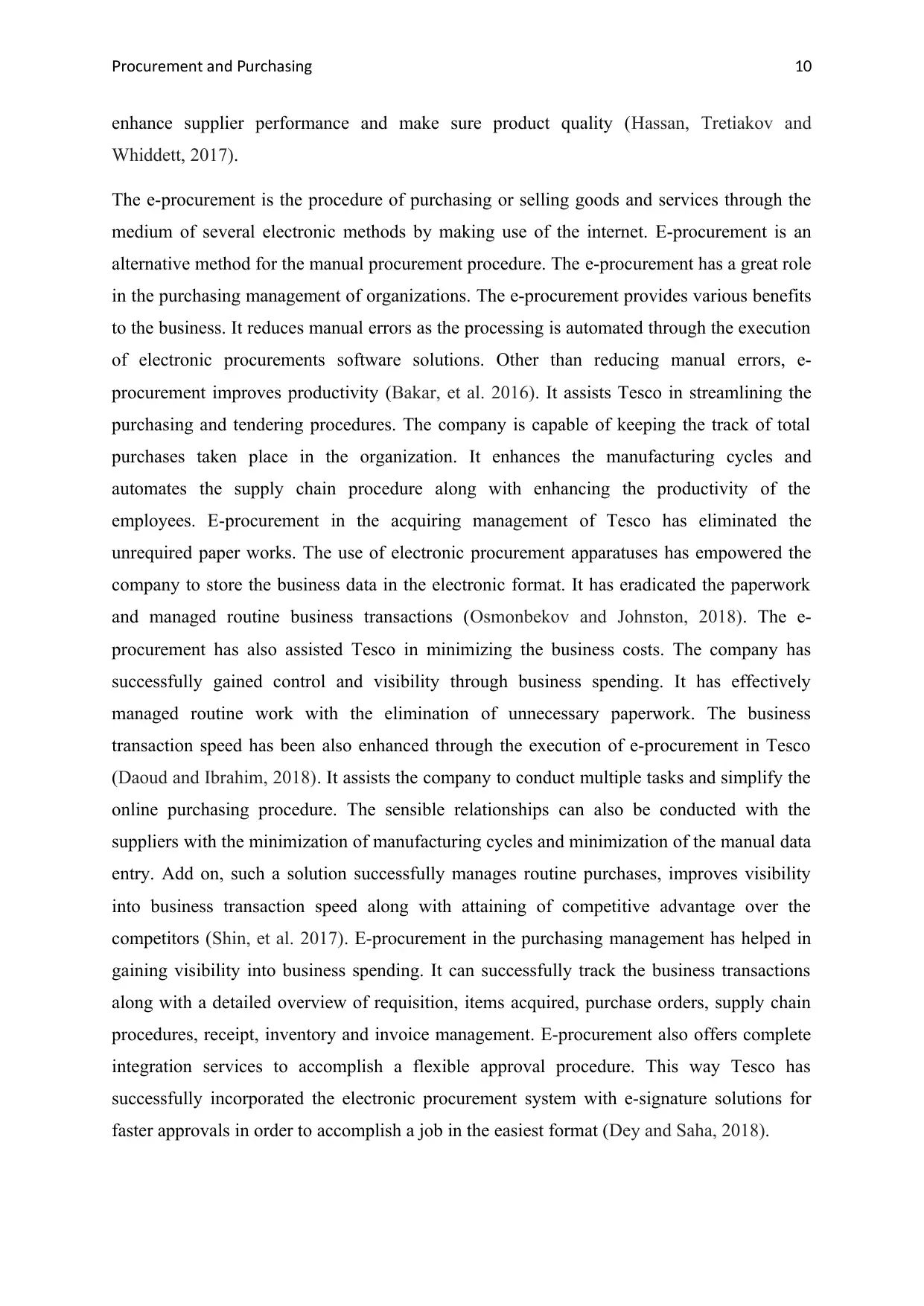
ro ure ent and ur asingP c m P ch 10
enhance supplier performance and make sure product quality (Hassan, Tretiakov and
Whiddett, 2017).
The e-procurement is the procedure of purchasing or selling goods and services through the
medium of several electronic methods by making use of the internet. E-procurement is an
alternative method for the manual procurement procedure. The e-procurement has a great role
in the purchasing management of organizations. The e-procurement provides various benefits
to the business. It reduces manual errors as the processing is automated through the execution
of electronic procurements software solutions. Other than reducing manual errors, e-
procurement improves productivity (Bakar, et al. 2016). It assists Tesco in streamlining the
purchasing and tendering procedures. The company is capable of keeping the track of total
purchases taken place in the organization. It enhances the manufacturing cycles and
automates the supply chain procedure along with enhancing the productivity of the
employees. E-procurement in the acquiring management of Tesco has eliminated the
unrequired paper works. The use of electronic procurement apparatuses has empowered the
company to store the business data in the electronic format. It has eradicated the paperwork
and managed routine business transactions (Osmonbekov and Johnston, 2018). The e-
procurement has also assisted Tesco in minimizing the business costs. The company has
successfully gained control and visibility through business spending. It has effectively
managed routine work with the elimination of unnecessary paperwork. The business
transaction speed has been also enhanced through the execution of e-procurement in Tesco
(Daoud and Ibrahim, 2018). It assists the company to conduct multiple tasks and simplify the
online purchasing procedure. The sensible relationships can also be conducted with the
suppliers with the minimization of manufacturing cycles and minimization of the manual data
entry. Add on, such a solution successfully manages routine purchases, improves visibility
into business transaction speed along with attaining of competitive advantage over the
competitors (Shin, et al. 2017). E-procurement in the purchasing management has helped in
gaining visibility into business spending. It can successfully track the business transactions
along with a detailed overview of requisition, items acquired, purchase orders, supply chain
procedures, receipt, inventory and invoice management. E-procurement also offers complete
integration services to accomplish a flexible approval procedure. This way Tesco has
successfully incorporated the electronic procurement system with e-signature solutions for
faster approvals in order to accomplish a job in the easiest format (Dey and Saha, 2018).
enhance supplier performance and make sure product quality (Hassan, Tretiakov and
Whiddett, 2017).
The e-procurement is the procedure of purchasing or selling goods and services through the
medium of several electronic methods by making use of the internet. E-procurement is an
alternative method for the manual procurement procedure. The e-procurement has a great role
in the purchasing management of organizations. The e-procurement provides various benefits
to the business. It reduces manual errors as the processing is automated through the execution
of electronic procurements software solutions. Other than reducing manual errors, e-
procurement improves productivity (Bakar, et al. 2016). It assists Tesco in streamlining the
purchasing and tendering procedures. The company is capable of keeping the track of total
purchases taken place in the organization. It enhances the manufacturing cycles and
automates the supply chain procedure along with enhancing the productivity of the
employees. E-procurement in the acquiring management of Tesco has eliminated the
unrequired paper works. The use of electronic procurement apparatuses has empowered the
company to store the business data in the electronic format. It has eradicated the paperwork
and managed routine business transactions (Osmonbekov and Johnston, 2018). The e-
procurement has also assisted Tesco in minimizing the business costs. The company has
successfully gained control and visibility through business spending. It has effectively
managed routine work with the elimination of unnecessary paperwork. The business
transaction speed has been also enhanced through the execution of e-procurement in Tesco
(Daoud and Ibrahim, 2018). It assists the company to conduct multiple tasks and simplify the
online purchasing procedure. The sensible relationships can also be conducted with the
suppliers with the minimization of manufacturing cycles and minimization of the manual data
entry. Add on, such a solution successfully manages routine purchases, improves visibility
into business transaction speed along with attaining of competitive advantage over the
competitors (Shin, et al. 2017). E-procurement in the purchasing management has helped in
gaining visibility into business spending. It can successfully track the business transactions
along with a detailed overview of requisition, items acquired, purchase orders, supply chain
procedures, receipt, inventory and invoice management. E-procurement also offers complete
integration services to accomplish a flexible approval procedure. This way Tesco has
successfully incorporated the electronic procurement system with e-signature solutions for
faster approvals in order to accomplish a job in the easiest format (Dey and Saha, 2018).
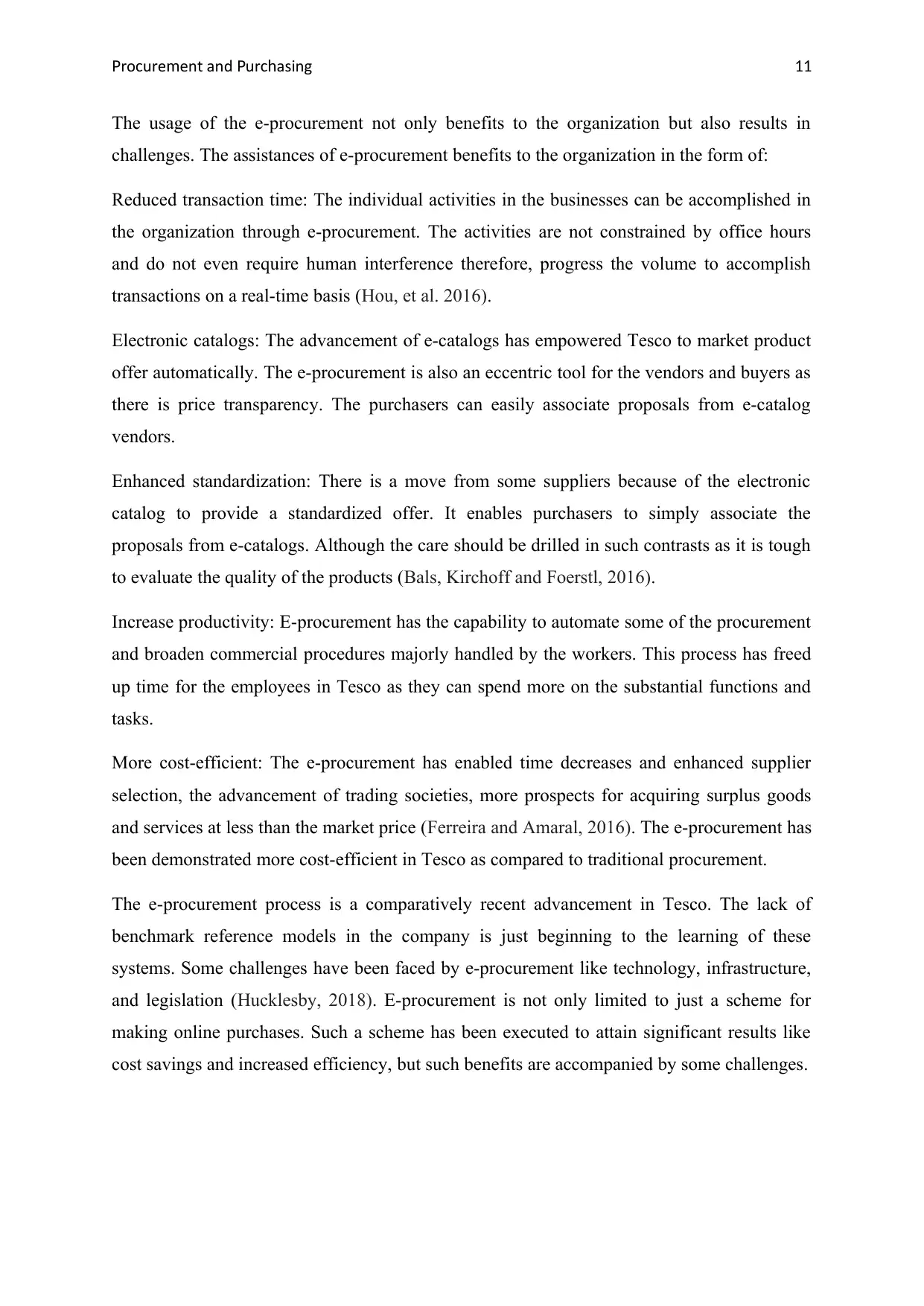
ro ure ent and ur asingP c m P ch 11
The usage of the e-procurement not only benefits to the organization but also results in
challenges. The assistances of e-procurement benefits to the organization in the form of:
Reduced transaction time: The individual activities in the businesses can be accomplished in
the organization through e-procurement. The activities are not constrained by office hours
and do not even require human interference therefore, progress the volume to accomplish
transactions on a real-time basis (Hou, et al. 2016).
Electronic catalogs: The advancement of e-catalogs has empowered Tesco to market product
offer automatically. The e-procurement is also an eccentric tool for the vendors and buyers as
there is price transparency. The purchasers can easily associate proposals from e-catalog
vendors.
Enhanced standardization: There is a move from some suppliers because of the electronic
catalog to provide a standardized offer. It enables purchasers to simply associate the
proposals from e-catalogs. Although the care should be drilled in such contrasts as it is tough
to evaluate the quality of the products (Bals, Kirchoff and Foerstl, 2016).
Increase productivity: E-procurement has the capability to automate some of the procurement
and broaden commercial procedures majorly handled by the workers. This process has freed
up time for the employees in Tesco as they can spend more on the substantial functions and
tasks.
More cost-efficient: The e-procurement has enabled time decreases and enhanced supplier
selection, the advancement of trading societies, more prospects for acquiring surplus goods
and services at less than the market price (Ferreira and Amaral, 2016). The e-procurement has
been demonstrated more cost-efficient in Tesco as compared to traditional procurement.
The e-procurement process is a comparatively recent advancement in Tesco. The lack of
benchmark reference models in the company is just beginning to the learning of these
systems. Some challenges have been faced by e-procurement like technology, infrastructure,
and legislation (Hucklesby, 2018). E-procurement is not only limited to just a scheme for
making online purchases. Such a scheme has been executed to attain significant results like
cost savings and increased efficiency, but such benefits are accompanied by some challenges.
The usage of the e-procurement not only benefits to the organization but also results in
challenges. The assistances of e-procurement benefits to the organization in the form of:
Reduced transaction time: The individual activities in the businesses can be accomplished in
the organization through e-procurement. The activities are not constrained by office hours
and do not even require human interference therefore, progress the volume to accomplish
transactions on a real-time basis (Hou, et al. 2016).
Electronic catalogs: The advancement of e-catalogs has empowered Tesco to market product
offer automatically. The e-procurement is also an eccentric tool for the vendors and buyers as
there is price transparency. The purchasers can easily associate proposals from e-catalog
vendors.
Enhanced standardization: There is a move from some suppliers because of the electronic
catalog to provide a standardized offer. It enables purchasers to simply associate the
proposals from e-catalogs. Although the care should be drilled in such contrasts as it is tough
to evaluate the quality of the products (Bals, Kirchoff and Foerstl, 2016).
Increase productivity: E-procurement has the capability to automate some of the procurement
and broaden commercial procedures majorly handled by the workers. This process has freed
up time for the employees in Tesco as they can spend more on the substantial functions and
tasks.
More cost-efficient: The e-procurement has enabled time decreases and enhanced supplier
selection, the advancement of trading societies, more prospects for acquiring surplus goods
and services at less than the market price (Ferreira and Amaral, 2016). The e-procurement has
been demonstrated more cost-efficient in Tesco as compared to traditional procurement.
The e-procurement process is a comparatively recent advancement in Tesco. The lack of
benchmark reference models in the company is just beginning to the learning of these
systems. Some challenges have been faced by e-procurement like technology, infrastructure,
and legislation (Hucklesby, 2018). E-procurement is not only limited to just a scheme for
making online purchases. Such a scheme has been executed to attain significant results like
cost savings and increased efficiency, but such benefits are accompanied by some challenges.
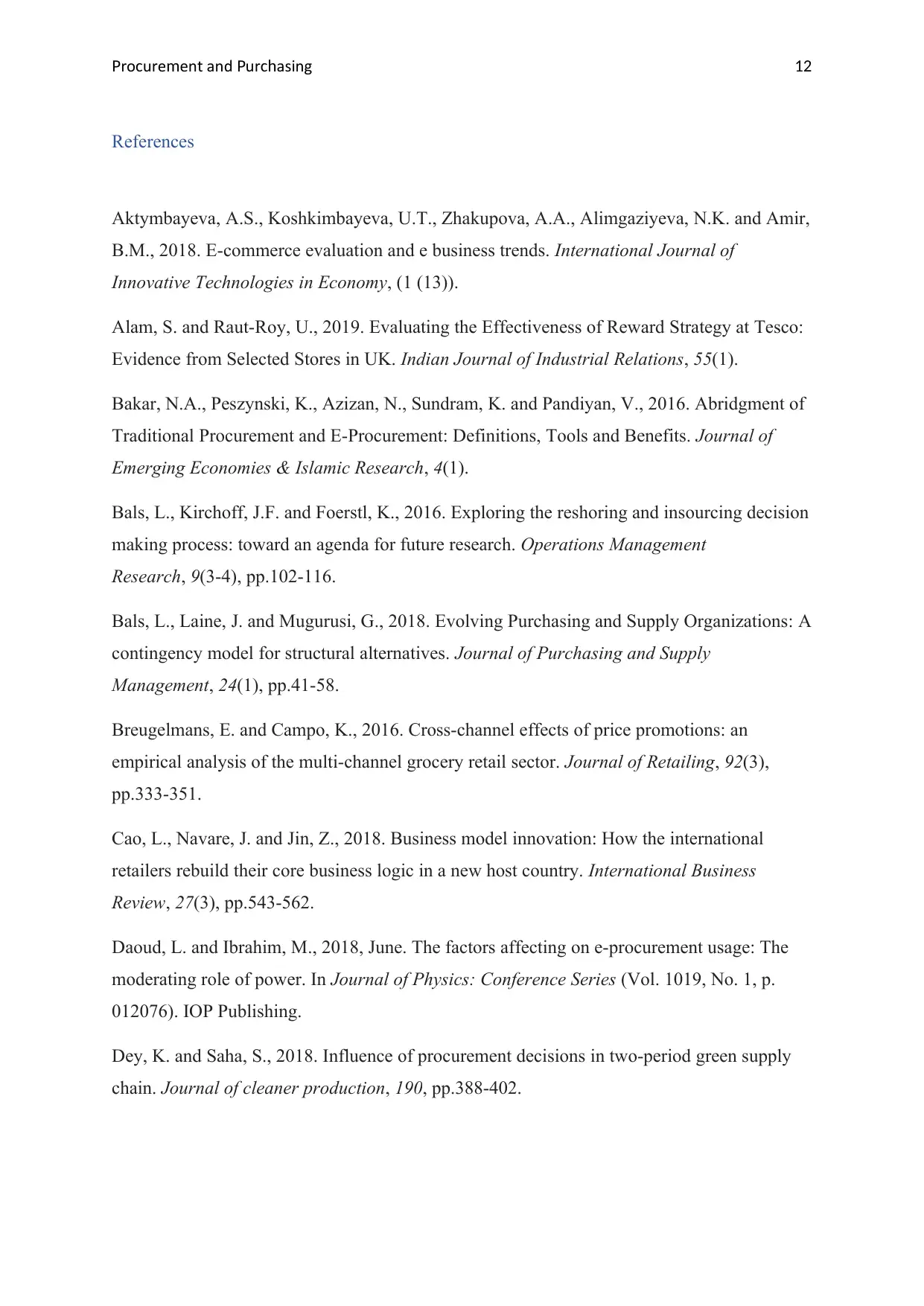
ro ure ent and ur asingP c m P ch 12
References
Aktymbayeva, A.S., Koshkimbayeva, U.T., Zhakupova, A.A., Alimgaziyeva, N.K. and Amir,
B.M., 2018. E-commerce evaluation and e business trends. International Journal of
Innovative Technologies in Economy, (1 (13)).
Alam, S. and Raut-Roy, U., 2019. Evaluating the Effectiveness of Reward Strategy at Tesco:
Evidence from Selected Stores in UK. Indian Journal of Industrial Relations, 55(1).
Bakar, N.A., Peszynski, K., Azizan, N., Sundram, K. and Pandiyan, V., 2016. Abridgment of
Traditional Procurement and E-Procurement: Definitions, Tools and Benefits. Journal of
Emerging Economies & Islamic Research, 4(1).
Bals, L., Kirchoff, J.F. and Foerstl, K., 2016. Exploring the reshoring and insourcing decision
making process: toward an agenda for future research. Operations Management
Research, 9(3-4), pp.102-116.
Bals, L., Laine, J. and Mugurusi, G., 2018. Evolving Purchasing and Supply Organizations: A
contingency model for structural alternatives. Journal of Purchasing and Supply
Management, 24(1), pp.41-58.
Breugelmans, E. and Campo, K., 2016. Cross-channel effects of price promotions: an
empirical analysis of the multi-channel grocery retail sector. Journal of Retailing, 92(3),
pp.333-351.
Cao, L., Navare, J. and Jin, Z., 2018. Business model innovation: How the international
retailers rebuild their core business logic in a new host country. International Business
Review, 27(3), pp.543-562.
Daoud, L. and Ibrahim, M., 2018, June. The factors affecting on e-procurement usage: The
moderating role of power. In Journal of Physics: Conference Series (Vol. 1019, No. 1, p.
012076). IOP Publishing.
Dey, K. and Saha, S., 2018. Influence of procurement decisions in two-period green supply
chain. Journal of cleaner production, 190, pp.388-402.
References
Aktymbayeva, A.S., Koshkimbayeva, U.T., Zhakupova, A.A., Alimgaziyeva, N.K. and Amir,
B.M., 2018. E-commerce evaluation and e business trends. International Journal of
Innovative Technologies in Economy, (1 (13)).
Alam, S. and Raut-Roy, U., 2019. Evaluating the Effectiveness of Reward Strategy at Tesco:
Evidence from Selected Stores in UK. Indian Journal of Industrial Relations, 55(1).
Bakar, N.A., Peszynski, K., Azizan, N., Sundram, K. and Pandiyan, V., 2016. Abridgment of
Traditional Procurement and E-Procurement: Definitions, Tools and Benefits. Journal of
Emerging Economies & Islamic Research, 4(1).
Bals, L., Kirchoff, J.F. and Foerstl, K., 2016. Exploring the reshoring and insourcing decision
making process: toward an agenda for future research. Operations Management
Research, 9(3-4), pp.102-116.
Bals, L., Laine, J. and Mugurusi, G., 2018. Evolving Purchasing and Supply Organizations: A
contingency model for structural alternatives. Journal of Purchasing and Supply
Management, 24(1), pp.41-58.
Breugelmans, E. and Campo, K., 2016. Cross-channel effects of price promotions: an
empirical analysis of the multi-channel grocery retail sector. Journal of Retailing, 92(3),
pp.333-351.
Cao, L., Navare, J. and Jin, Z., 2018. Business model innovation: How the international
retailers rebuild their core business logic in a new host country. International Business
Review, 27(3), pp.543-562.
Daoud, L. and Ibrahim, M., 2018, June. The factors affecting on e-procurement usage: The
moderating role of power. In Journal of Physics: Conference Series (Vol. 1019, No. 1, p.
012076). IOP Publishing.
Dey, K. and Saha, S., 2018. Influence of procurement decisions in two-period green supply
chain. Journal of cleaner production, 190, pp.388-402.
Paraphrase This Document
Need a fresh take? Get an instant paraphrase of this document with our AI Paraphraser
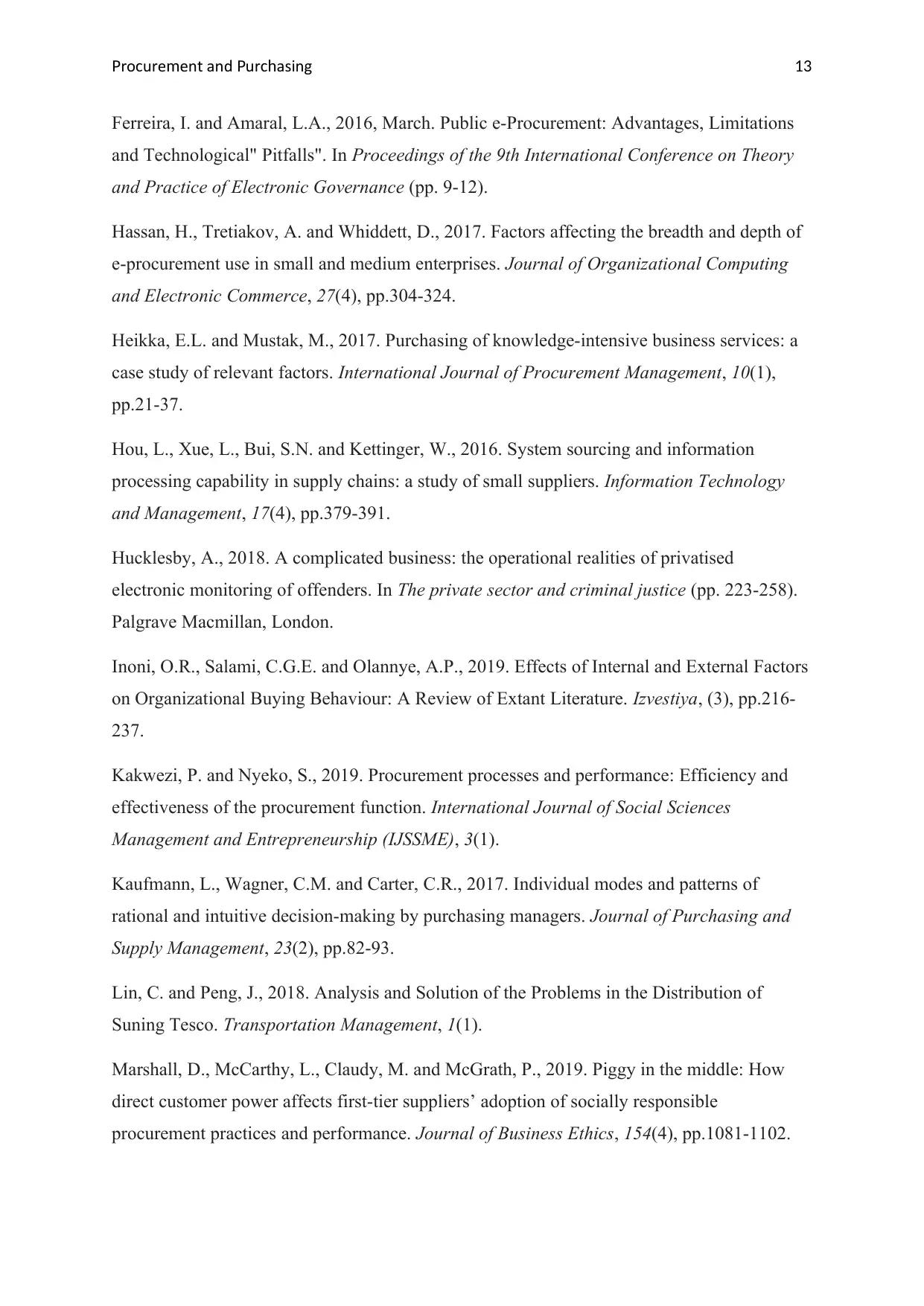
ro ure ent and ur asingP c m P ch 13
Ferreira, I. and Amaral, L.A., 2016, March. Public e-Procurement: Advantages, Limitations
and Technological" Pitfalls". In Proceedings of the 9th International Conference on Theory
and Practice of Electronic Governance (pp. 9-12).
Hassan, H., Tretiakov, A. and Whiddett, D., 2017. Factors affecting the breadth and depth of
e-procurement use in small and medium enterprises. Journal of Organizational Computing
and Electronic Commerce, 27(4), pp.304-324.
Heikka, E.L. and Mustak, M., 2017. Purchasing of knowledge-intensive business services: a
case study of relevant factors. International Journal of Procurement Management, 10(1),
pp.21-37.
Hou, L., Xue, L., Bui, S.N. and Kettinger, W., 2016. System sourcing and information
processing capability in supply chains: a study of small suppliers. Information Technology
and Management, 17(4), pp.379-391.
Hucklesby, A., 2018. A complicated business: the operational realities of privatised
electronic monitoring of offenders. In The private sector and criminal justice (pp. 223-258).
Palgrave Macmillan, London.
Inoni, O.R., Salami, C.G.E. and Olannye, A.P., 2019. Effects of Internal and External Factors
on Organizational Buying Behaviour: A Review of Extant Literature. Izvestiya, (3), pp.216-
237.
Kakwezi, P. and Nyeko, S., 2019. Procurement processes and performance: Efficiency and
effectiveness of the procurement function. International Journal of Social Sciences
Management and Entrepreneurship (IJSSME), 3(1).
Kaufmann, L., Wagner, C.M. and Carter, C.R., 2017. Individual modes and patterns of
rational and intuitive decision-making by purchasing managers. Journal of Purchasing and
Supply Management, 23(2), pp.82-93.
Lin, C. and Peng, J., 2018. Analysis and Solution of the Problems in the Distribution of
Suning Tesco. Transportation Management, 1(1).
Marshall, D., McCarthy, L., Claudy, M. and McGrath, P., 2019. Piggy in the middle: How
direct customer power affects first-tier suppliers’ adoption of socially responsible
procurement practices and performance. Journal of Business Ethics, 154(4), pp.1081-1102.
Ferreira, I. and Amaral, L.A., 2016, March. Public e-Procurement: Advantages, Limitations
and Technological" Pitfalls". In Proceedings of the 9th International Conference on Theory
and Practice of Electronic Governance (pp. 9-12).
Hassan, H., Tretiakov, A. and Whiddett, D., 2017. Factors affecting the breadth and depth of
e-procurement use in small and medium enterprises. Journal of Organizational Computing
and Electronic Commerce, 27(4), pp.304-324.
Heikka, E.L. and Mustak, M., 2017. Purchasing of knowledge-intensive business services: a
case study of relevant factors. International Journal of Procurement Management, 10(1),
pp.21-37.
Hou, L., Xue, L., Bui, S.N. and Kettinger, W., 2016. System sourcing and information
processing capability in supply chains: a study of small suppliers. Information Technology
and Management, 17(4), pp.379-391.
Hucklesby, A., 2018. A complicated business: the operational realities of privatised
electronic monitoring of offenders. In The private sector and criminal justice (pp. 223-258).
Palgrave Macmillan, London.
Inoni, O.R., Salami, C.G.E. and Olannye, A.P., 2019. Effects of Internal and External Factors
on Organizational Buying Behaviour: A Review of Extant Literature. Izvestiya, (3), pp.216-
237.
Kakwezi, P. and Nyeko, S., 2019. Procurement processes and performance: Efficiency and
effectiveness of the procurement function. International Journal of Social Sciences
Management and Entrepreneurship (IJSSME), 3(1).
Kaufmann, L., Wagner, C.M. and Carter, C.R., 2017. Individual modes and patterns of
rational and intuitive decision-making by purchasing managers. Journal of Purchasing and
Supply Management, 23(2), pp.82-93.
Lin, C. and Peng, J., 2018. Analysis and Solution of the Problems in the Distribution of
Suning Tesco. Transportation Management, 1(1).
Marshall, D., McCarthy, L., Claudy, M. and McGrath, P., 2019. Piggy in the middle: How
direct customer power affects first-tier suppliers’ adoption of socially responsible
procurement practices and performance. Journal of Business Ethics, 154(4), pp.1081-1102.
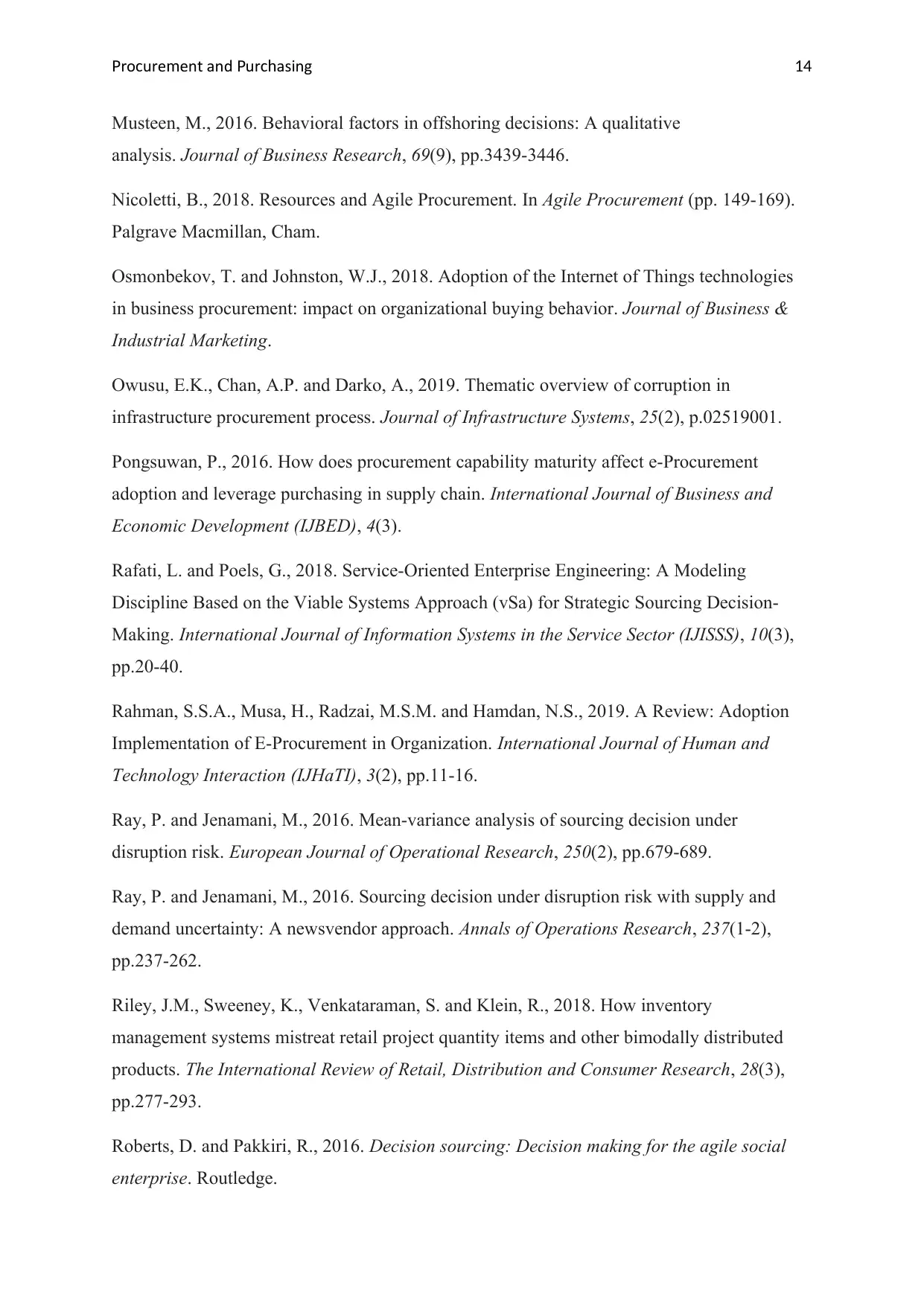
ro ure ent and ur asingP c m P ch 14
Musteen, M., 2016. Behavioral factors in offshoring decisions: A qualitative
analysis. Journal of Business Research, 69(9), pp.3439-3446.
Nicoletti, B., 2018. Resources and Agile Procurement. In Agile Procurement (pp. 149-169).
Palgrave Macmillan, Cham.
Osmonbekov, T. and Johnston, W.J., 2018. Adoption of the Internet of Things technologies
in business procurement: impact on organizational buying behavior. Journal of Business &
Industrial Marketing.
Owusu, E.K., Chan, A.P. and Darko, A., 2019. Thematic overview of corruption in
infrastructure procurement process. Journal of Infrastructure Systems, 25(2), p.02519001.
Pongsuwan, P., 2016. How does procurement capability maturity affect e-Procurement
adoption and leverage purchasing in supply chain. International Journal of Business and
Economic Development (IJBED), 4(3).
Rafati, L. and Poels, G., 2018. Service-Oriented Enterprise Engineering: A Modeling
Discipline Based on the Viable Systems Approach (vSa) for Strategic Sourcing Decision-
Making. International Journal of Information Systems in the Service Sector (IJISSS), 10(3),
pp.20-40.
Rahman, S.S.A., Musa, H., Radzai, M.S.M. and Hamdan, N.S., 2019. A Review: Adoption
Implementation of E-Procurement in Organization. International Journal of Human and
Technology Interaction (IJHaTI), 3(2), pp.11-16.
Ray, P. and Jenamani, M., 2016. Mean-variance analysis of sourcing decision under
disruption risk. European Journal of Operational Research, 250(2), pp.679-689.
Ray, P. and Jenamani, M., 2016. Sourcing decision under disruption risk with supply and
demand uncertainty: A newsvendor approach. Annals of Operations Research, 237(1-2),
pp.237-262.
Riley, J.M., Sweeney, K., Venkataraman, S. and Klein, R., 2018. How inventory
management systems mistreat retail project quantity items and other bimodally distributed
products. The International Review of Retail, Distribution and Consumer Research, 28(3),
pp.277-293.
Roberts, D. and Pakkiri, R., 2016. Decision sourcing: Decision making for the agile social
enterprise. Routledge.
Musteen, M., 2016. Behavioral factors in offshoring decisions: A qualitative
analysis. Journal of Business Research, 69(9), pp.3439-3446.
Nicoletti, B., 2018. Resources and Agile Procurement. In Agile Procurement (pp. 149-169).
Palgrave Macmillan, Cham.
Osmonbekov, T. and Johnston, W.J., 2018. Adoption of the Internet of Things technologies
in business procurement: impact on organizational buying behavior. Journal of Business &
Industrial Marketing.
Owusu, E.K., Chan, A.P. and Darko, A., 2019. Thematic overview of corruption in
infrastructure procurement process. Journal of Infrastructure Systems, 25(2), p.02519001.
Pongsuwan, P., 2016. How does procurement capability maturity affect e-Procurement
adoption and leverage purchasing in supply chain. International Journal of Business and
Economic Development (IJBED), 4(3).
Rafati, L. and Poels, G., 2018. Service-Oriented Enterprise Engineering: A Modeling
Discipline Based on the Viable Systems Approach (vSa) for Strategic Sourcing Decision-
Making. International Journal of Information Systems in the Service Sector (IJISSS), 10(3),
pp.20-40.
Rahman, S.S.A., Musa, H., Radzai, M.S.M. and Hamdan, N.S., 2019. A Review: Adoption
Implementation of E-Procurement in Organization. International Journal of Human and
Technology Interaction (IJHaTI), 3(2), pp.11-16.
Ray, P. and Jenamani, M., 2016. Mean-variance analysis of sourcing decision under
disruption risk. European Journal of Operational Research, 250(2), pp.679-689.
Ray, P. and Jenamani, M., 2016. Sourcing decision under disruption risk with supply and
demand uncertainty: A newsvendor approach. Annals of Operations Research, 237(1-2),
pp.237-262.
Riley, J.M., Sweeney, K., Venkataraman, S. and Klein, R., 2018. How inventory
management systems mistreat retail project quantity items and other bimodally distributed
products. The International Review of Retail, Distribution and Consumer Research, 28(3),
pp.277-293.
Roberts, D. and Pakkiri, R., 2016. Decision sourcing: Decision making for the agile social
enterprise. Routledge.
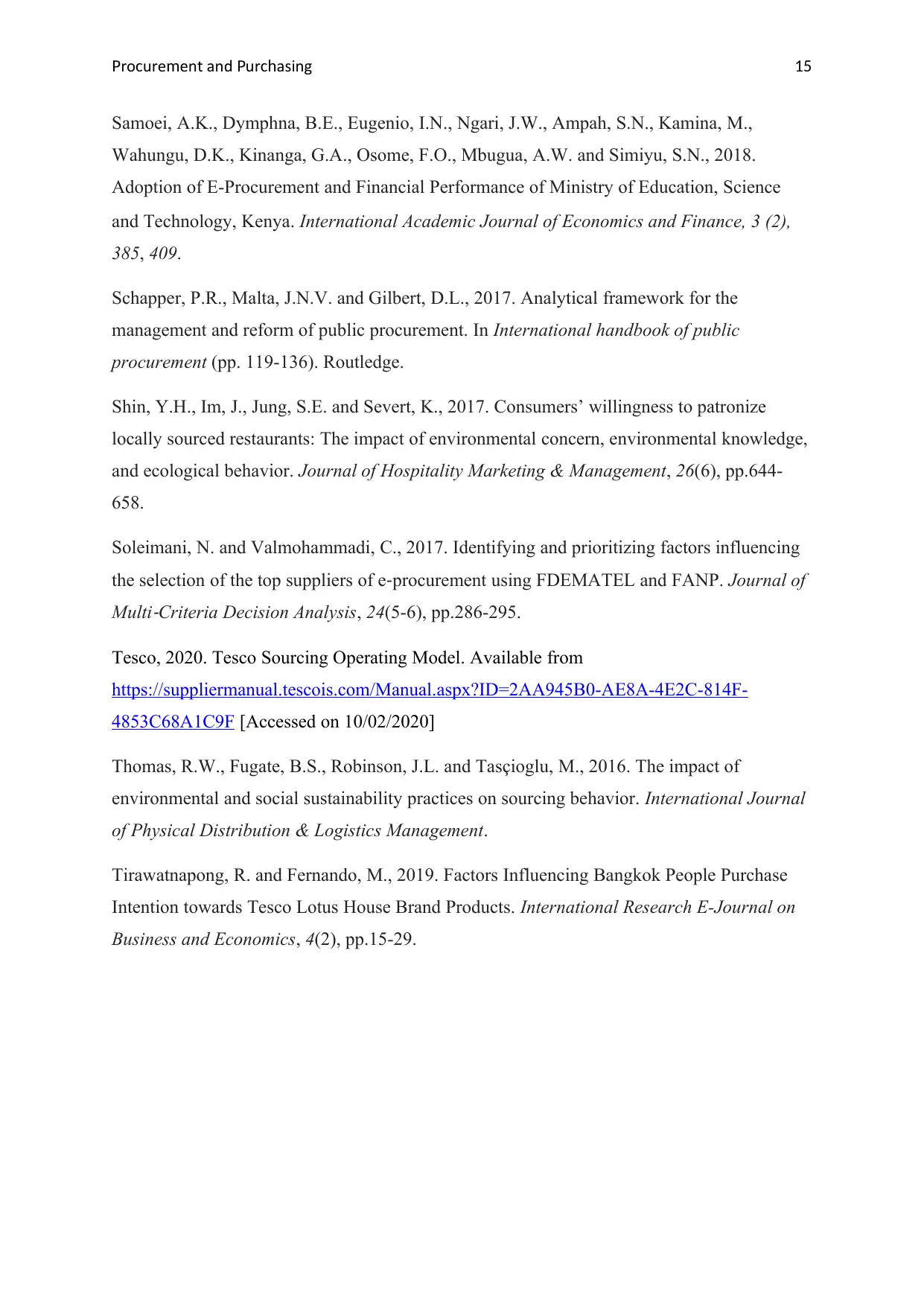
ro ure ent and ur asingP c m P ch 15
Samoei, A.K., Dymphna, B.E., Eugenio, I.N., Ngari, J.W., Ampah, S.N., Kamina, M.,
Wahungu, D.K., Kinanga, G.A., Osome, F.O., Mbugua, A.W. and Simiyu, S.N., 2018.
Adoption of E-Procurement and Financial Performance of Ministry of Education, Science
and Technology, Kenya. International Academic Journal of Economics and Finance, 3 (2),
385, 409.
Schapper, P.R., Malta, J.N.V. and Gilbert, D.L., 2017. Analytical framework for the
management and reform of public procurement. In International handbook of public
procurement (pp. 119-136). Routledge.
Shin, Y.H., Im, J., Jung, S.E. and Severt, K., 2017. Consumers’ willingness to patronize
locally sourced restaurants: The impact of environmental concern, environmental knowledge,
and ecological behavior. Journal of Hospitality Marketing & Management, 26(6), pp.644-
658.
Soleimani, N. and Valmohammadi, C., 2017. Identifying and prioritizing factors influencing
the selection of the top suppliers of e‐procurement using FDEMATEL and FANP. Journal of
Multi
‐Criteria Decision Analysis, 24(5-6), pp.286-295.
Tesco, 2020. Tesco Sourcing Operating Model. Available from
https://suppliermanual.tescois.com/Manual.aspx?ID=2AA945B0-AE8A-4E2C-814F-
4853C68A1C9F [Accessed on 10/02/2020]
Thomas, R.W., Fugate, B.S., Robinson, J.L. and Tasçioglu, M., 2016. The impact of
environmental and social sustainability practices on sourcing behavior. International Journal
of Physical Distribution & Logistics Management.
Tirawatnapong, R. and Fernando, M., 2019. Factors Influencing Bangkok People Purchase
Intention towards Tesco Lotus House Brand Products. International Research E-Journal on
Business and Economics, 4(2), pp.15-29.
Samoei, A.K., Dymphna, B.E., Eugenio, I.N., Ngari, J.W., Ampah, S.N., Kamina, M.,
Wahungu, D.K., Kinanga, G.A., Osome, F.O., Mbugua, A.W. and Simiyu, S.N., 2018.
Adoption of E-Procurement and Financial Performance of Ministry of Education, Science
and Technology, Kenya. International Academic Journal of Economics and Finance, 3 (2),
385, 409.
Schapper, P.R., Malta, J.N.V. and Gilbert, D.L., 2017. Analytical framework for the
management and reform of public procurement. In International handbook of public
procurement (pp. 119-136). Routledge.
Shin, Y.H., Im, J., Jung, S.E. and Severt, K., 2017. Consumers’ willingness to patronize
locally sourced restaurants: The impact of environmental concern, environmental knowledge,
and ecological behavior. Journal of Hospitality Marketing & Management, 26(6), pp.644-
658.
Soleimani, N. and Valmohammadi, C., 2017. Identifying and prioritizing factors influencing
the selection of the top suppliers of e‐procurement using FDEMATEL and FANP. Journal of
Multi
‐Criteria Decision Analysis, 24(5-6), pp.286-295.
Tesco, 2020. Tesco Sourcing Operating Model. Available from
https://suppliermanual.tescois.com/Manual.aspx?ID=2AA945B0-AE8A-4E2C-814F-
4853C68A1C9F [Accessed on 10/02/2020]
Thomas, R.W., Fugate, B.S., Robinson, J.L. and Tasçioglu, M., 2016. The impact of
environmental and social sustainability practices on sourcing behavior. International Journal
of Physical Distribution & Logistics Management.
Tirawatnapong, R. and Fernando, M., 2019. Factors Influencing Bangkok People Purchase
Intention towards Tesco Lotus House Brand Products. International Research E-Journal on
Business and Economics, 4(2), pp.15-29.
1 out of 16
Your All-in-One AI-Powered Toolkit for Academic Success.
+13062052269
info@desklib.com
Available 24*7 on WhatsApp / Email
![[object Object]](/_next/static/media/star-bottom.7253800d.svg)
Unlock your academic potential
© 2024 | Zucol Services PVT LTD | All rights reserved.



